STANLEY KUBRICK'S
THE KILLING
A SHOT-BY-SHOT ANALYSIS
PART THREE

Go to TOC for this film ( (which has also a statement on purpose and manner of analysis and a disclaimer as to caveat emptor and my knowing anything authoritatively, which I do not, but I do try to not know earnestly, with some discretion, and considerable thought).
TOC and Supplemental Posts | Part 1 | Part 2 | Part 3 | Part 4 | Films Home
LINKS TO SECTIONS OF THE ANALYSIS ON THIS PAGE:
Storyline Sequence Differences with the Novel for this Section
Saturday 7:30 AM, Breakfast with Sherry and George, Shots 128 through 132
Breakfast with George and Sherry: Things to Note. Did it happen this way in the novel? George's mask. Sherry's lie about her conversation with George.
Saturday 5:00 AM, Breakfast with Red Lightning, Shots 133 through 134
Breakfast with Red Lightning: Things to Note. Not in the book. Oats. Another flip/inversion. Red Lightning and the invisible horse in Killer's Kiss.
Saturday 7:00 AM, Johnny and Marvin, Shots 135 through 146
Johnny and Marvin: Things to Note. The conversation between Marvin and Johnny. Comparing this scene to Johnny and Sherry in the bed.
Saturday 7:00 AM, The Airport, Shots 147 through 148
The Airport: Things to Note. Timeline error. The book's tip for the cab driver and Eyes Wide Shut. 7 thru 9 and the Chess Academy.
Saturday 8:15 AM, The Motel, Shots 149 through 151
The Motel: Things to Note. Those screen doors. Eavesdropping. Ariel and errors.
Saturday 8:45 AM, The Bus Station, Shots152
The Bus Station: Things to Note. Location. 504, 405 and 45.
Saturday 9:20 AM, Mike's Apartment, Shots 153 through 155
Johnny at Mike's Apartment: Things to Note.
Saturday 11:15 AM, Mike's Apartment, Shots 156 through 166
Mike Leaves His Apartment: Things to Note.
Saturday 11:29 AM, The Bus Station, Shots 167
Saturday 12:10 PM, The Track, Shots 168 through 176
12:10 at the Track: Things to Note. Human error and/or fate.
The First Race, Marvin Shows Up When He Should Be at a Movie, Shots 177 through 185
The First Race: Things to Note. Not according to plan? Parallels with Pagliacci. Marvin goes to a movie by appearing within one, and this highlights the play within a play aspect of the men performing roles for the heist.
Saturday 3:32 PM, Randy's Radio Goes Dead and He Takes Up His Station, Shots 186 through 193
Saturday 3:32 PM, Randy's Radio Goes Dead: Things to Note. Location. The dead radio. Maternity. Southwest. Seven.
Saturday 2:30 PM, The Chess Club, Maurice at the Track by 4:00, Shots 194 through 233
Maurice Goes From the Chess Club to the Track Where He Has His Fight: Things to Note. Similarity of the Chess Club window shadows to the race track. 204,42 and 4:20. The woman at window 202 in shot 204. The Irish pig and the sweeper. Closed 7 AM through 9 AM. There are some things, my dear Fisher, which do not bear much looking into. Back to Pagliacci. Shot 216.
Saturday 11:40 AM, Nikki, Shot 234
Saturday 11:40 AM: Things to Note. 11:40.
Saturday 12:30 PM, Nikki at the Track, Shots 235 through 280
Saturday 12:30 PM, Nikki at the Track: Things to Note. Differences between the book. The irony of the ornamental good luck horse shoe. The cars behind Nikki. The horse shoe and The Man Between. The horseshoe and The Shining and Lolita.
What Happens if We Remove the Narration for This Day?
The differences between the movie and book are significant for this section so I thought I'd lead off with them here, and then continue with them in section four.
In the book, Saturday begins with Marvin Unger at 10:30 am. He is by himself, meditating on how things might turn out, and has already decided he will go to the track and keep a watch on the happenings from the stands. He will not become involved in the action, as he does in the film.
Next, Mike is having breakfast with his wife, who is as characteristically affectionate as Sherry is underhanded and devious in the film. Mike leaves and passing a hardware store on the way to the subway he sees it's 10:30 a.m. Instead of going straight to the track, at Penn station he goes to the lockers and takes a florist's box containing Johnny's gun from locker 809. He's at the track by noon.
Then the book skips to Sherry and George (which I'll cover in a moment). George and Mike are on the same subway train to the track at noon.
Next Randy is going on duty at 8 am. At 12:30 he calls in and says he's going to lunch, then calls in at 1. At 2 he calls in from a drugstore on W 61st Street and says he's Lieutenant O'Malley's brother-in-law and that the Lieutenant's wife, his sister, is sick. He asks the sergeant to contact the Lieutenant. He figures the Lieutenant will have to go to his sister as his sister doesn't have a phone, and if there were any calls for Randy between 3 and 5 then his superior, O'Malley, wouldn't be on duty and his replacement would assume, if he tried to contact Randy but couldn't, that his radio was broken. A call comes in for him at 2:50 which he ignores (a fight). He is at the track at 4:30. At 4:35 he hears the crowd roaring, the race has started. At 4:40 the crowd falls silent and then breaks into a hysterical cacophony as he waits beneath the window out which the bag will be thrown.
At 8:30 am Maurice goes to a cafeteria, then leaves 45 minutes later. He goes to 42nd Street and speaks to his lawyer about bailing him out, if need be, at 6:30. He kills a little bit of time watching newsreels in a theater, then catches the 12:30 to the track. He stays at the bar throughout and is there when the fight with Tex begins.
The day starts for Tex with a prostitute in Hoboken. He takes a taxi to the train and the 12:30 to the track. He eats first then goes to the bar by the third race. At 4:25 the bugle sounds for the big race that will begin in 12 minutes. He starts his fight with Mike. He manages to fight with the guards for the full 12 minutes until the race begins.
Nikki rides in from the Catskills at midnight, arriving in NY at 3:30 am. He stays in a hotel and is up and ready to leave by 8. He rents an MG with canvas side curtains. Changes its plates. He reaches the parking lot of the track about 12:40. Around the 5th race he puts up the side curtains. He successfully kills the horse in the 7th race.
At 4:30 Val Cannon is occupied with beating Sherry up, trying to get information from her.
Finally the book gets around to Johnny, who is up at 8 am, staying in a hotel. He had already been to Joe Piano's the day before to drop off the gun and tell Joe about the cop that would stop by at 6 or 6:30, then dropped the suitcase off at Penn Station for Mike (it's described at that point in the book as a suitcase rather than a florist's box) and had a messenger service take the key to the locker to Mike's. He leaves the hotel at 11 am. He checks his own suitcase at La Guardia, goes to a restaurant, leaves by 1 and arrives at the track at 1:40. He arranges for the cab to wait for him (so he won't get stuck in traffic afterwards). He gives the cabbie 10, tells the cabbie to try his luck, and tells him he'll give him another 10 later. At 4:20 Johnny is leaning on the wall five feet from the door. Tex starts his fight. George lets him in the door. Johnny takes the flower box out of Mike's locker, puts together his gun.
Skip to Maxie Flam, the jockey, at the starting line, thinking of his plans to retire. The race begins, then he's later in the hospital, unaware of what had happened.
The novel then returns to Johnny and the robbery as he begins the stick-up portion...
Note that the book definitely reads that Johnny drops a suitcase off at the locker at Penn station for Mike when it should instead read he drops off a florist box.
Johnny found a cab on Second Avenue and told the driver to take him to Penn Station. He carried the suitcase into the lobby and found the bank of steel lockers. Checking the suitcase, he took the key and put it in an envelope. That night he had a messenger service drop it off at Big Mike's apartment.
Below is when Mike get's the box.
He left the subway at Penn Station, but instead of going downstairs to the Long Island division, he went up to the main lobby. He found the bank of steel lockers exactly where Johnny had told him they would be.
Carefully he looked around after locating number 809. He saw no one he knew.
Mike took the key and inserted it and turned. He pulled the door open.
It was a florist's box, about three feet long, twelve inches wide and eight inches deep. It was beautifully wrapped and tied with a large red ribbon. There was only one thing wrong with it. It weighed about twenty-five pounds.
Searching the book on my Kindle, the only previous mention of a florist, other than Mike taking the florist box from his locker, is the first day when George is on the way home. Knowing he'd failed Sherry as a husband, wishing he could tell her about the heist, he stops at the florist and picks her up some roses then takes the subway and express up to 110th Street where I assume they live.
128 MS of Sherry getting out of bed. (37:22)
NARRATOR: Four days later, at 7:30 a.m., Sherry Peatty was wide awake.
She goes to the kitchen.
129 MS George at the kitchen table. (37:36)
GEORGE: Gosh, honey, did I wake you up? I'm sorry. I just couldn't sleep somehow.
SHERRY: It's all right. Can I get you anything? Would you like some more coffee?
GEORGE: No, I guess not. Nice of you to offer though. I don't know, I'm just nervous and restless. I, I'll be all right. Go on back to bed, will you?
SHERRY: No, I won't. Even if I don't get up and get my husband's breakfast, the least I can do is sit with him while he has his coffee.
GEORGE: Ah, Sherry, are you sure you feel all right? I'm sorry. I didn't mean that the way it sounded.
SHERRY: I deserved it. I know I've been irritable and moody lately, and I haven't acted like I should. It's just I can't stand living like this. This crummy apartment and a hamburger for dinner.
GEORGE: You haven't been so bad, baby.
SHERRY: Yes, I have. But things are gonna be different. You'll see. When we get all that money and have so many nice things, I'll stop thinking about myself so much. Your problems will be my problems. Whenever you're worried about something--like now, for instance--is it the robbery? Is that what you're worrying about?
GEORGE: Yeah, I guess it is a little. I have no reason to. I know it's gonna be all right.
SHERRY: Ah, naturally you'd be a little upset at a time like this. It's today, isn't it?
GEORGE: Huh? What makes you think that? Just because I couldn't sleep, it doesn't mean that I...
SHERRY: I know my Georgie. He can't fool me. I'm right, aren't I, darling? Today is the day we get all that money.
GEORGE: No, you ain't. It isn't today. If you don't stop pestering me, trying to find out something you have no reason to know, there ain't gonna be no money.
SHERRY: But, George, how can you...
GEORGE: I mean it, Sherry! Now, I'm getting fed up. You heard what Johnny told you, to stop butting in. Mind your own business or he'd call this whole thing off.
SHERRY: And he told me something else, too, which I neglected to tell you--that if I did butt in, as you and he choose to call it--that he'd break my neck.
GEORGE: Maybe he had reason to. He wanted to make you understand that he means business.
SHERRY: All I've gotta say is you've certainly changed your tune since he and his friends slapped you around.
GEORGE: Well, I was pretty sore about that, but, after all, what could they do? You said yourself they acted pretty reasonable. We have no reason to hold a grudge.
SHERRY: Well, I'm not going to argue with you, George. If you let people beat you up, and then take their side against your own wife, why...
GEORGE: But you did, Sherry. You said--Look, I wanted to quit! You wouldn't let me. You said I had no reason to. Anyway, Johnny didn't lay a hand on me. None of the guys did but Randy.
SHERRY: I was gonna tell you something about your dear friend, Johnny, but since you feel about him like you do, take his word against mine...
130 MCU of George. (39:56)
GEORGE: What about him? What were you gonna tell me?
SHERRY: Let's stop the conversation right there.
GEORGE: What were you gonna tell me, Sherry?
SHERRY: I don't think I can tell you when you feel like you do about him, not having any faith in me and keeping secrets.
GEORGE: We won't have any secrets. What happened?
131 MS of Sherry. (40:16)
SHERRY: Well, I tried to tell you about this the other night, but you were so upset and every time I tried to say anything you cut me off.
132 MCU of George. (40:24)
GEORGE: Sherry, what are you trying to tell me?
SHERRY: I tried to stop him. I pleaded and I struggled. It doesn't matter, does it darling. The only thing that really matters is how I feel about you, now, isn't it? It is today, isn't it?
George shakes his head, yes.
Shot 128 | Shot 129 |
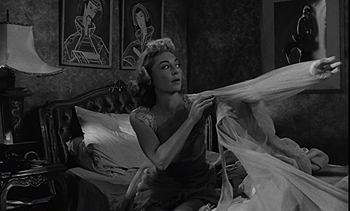 |  |
Shot 130 | Shot 131 |
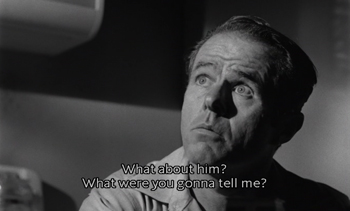 | 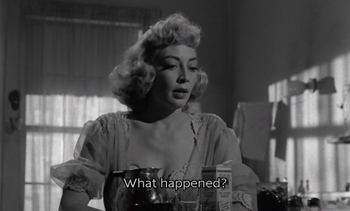 |
Shot 132 | |
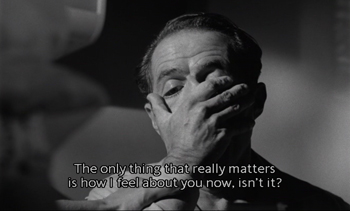 | |
Did Johnny rape Sherry in the book? No, it didn't happen this way in the novel. Sherry and Johnny kissed that first night and planned to get together, but Johnny shuffled her off to Randy as Randy was good with women and Johnny didn't want to be bothered. So when Johnny and Sherry were to next meet at Marvin's, Randy showed up instead. As it turned out, Randy and Sherry seem to have been made for one another and fell right in love. Sherry adored him. He was all she could think about. As it also happened, unbeknownst to Randy and Sherry or anyone else, George decided to not go into work that particular day and happened to see Sherry leaving Marvin's and concluded she was having an affair with Johnny. The morning of the heist, Sherry sees George with a gun (the gun is new, he seems to be already thinking of killing Johnny) and guesses the robbery will be that day. She doesn't tell George a lie that Johnny had raped her. Nothing of the sort.
In the movie, as well, George carries a gun with him to the track but we don't see it until George is in the dressing room. Due to what Sherry had told him about the rape, George in the movie is likely thinking of killing Johnny but it doesn't seem he's going to dispense with Johnny until after Johnny pulls the heist.
The way that George slides his hand over his face, stretching it, his eyes misshapen, reminds me a bit of Johnny in his clown mask, and I wonder if this is supposed to be George, as Pagliaccio, putting on his mask. All of these men will be wearing "masks" as they go about their theatricals this day of the heist, each inhabiting a lie, playing their parts, but George will have the burden of having to interact with Johnny as if everything is all right, when instead he believes that Johnny raped Sherry.
Sherry claimed that she had tried to tell George about the rape the previous Saturday night but that he cut her off each time. George chooses to forget that he was the one who brought it up that Saturday night and that each time he did Sherry cut him off. He asked, "What did Johnny do to you?" to which she replied that he only asked her some questions. George asked again, "Sherry, did Johnny try anything?" to which she replied that it was a terrible thing for him to ask.
133 MS of horse in stall. (40:48)
NARRATOR: Earlier that morning, at 5:00 a.m., Red Lightning was fed only a half portion of feed...
134 LS of stalls. (40:52)
NARRATOR: ...in preparation for the 7th race that afternoon, the $100,000 Lansdowne Stakes.
Shot 133 | Shot 134 |
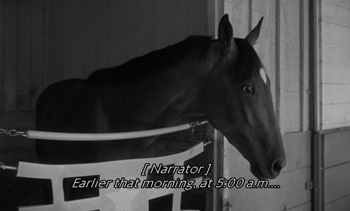 | 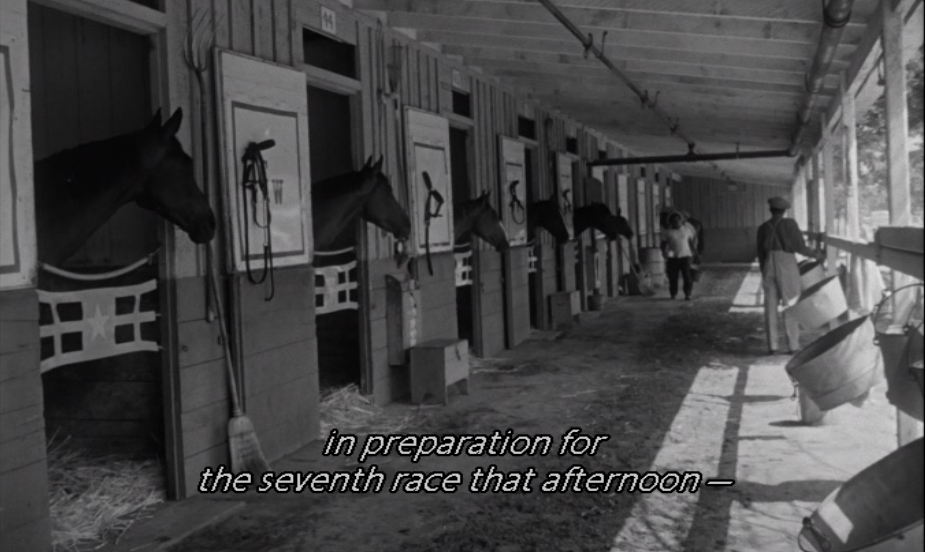 |
This may have been considered a replacement of the scene with the jockey who at the beginning of the race is thinking about his retirement. Jockeys, too, are on harsh dietary regimens due to having to keep their weight down. This concern has been transferred to the horse. The segment contributes nothing other than to make us aware that the horse that is gunned down is not the same one as in shots 133 and 134. The horse here has a white "star" on its forehead. The horse that is shot clearly has a wide blaze strip that goes all the way down the middle of the face.
What do horses eat? Oats, as far as I know. At least it's a significant portion of their diet. If we go back to shot 45, what do we see in Marvin's kitchen as Johnny pops the top off a beer? A container of Quaker Oats. I think that's the only food we clearly see in the kitchen. Perhaps an inside joke.
One will assume that shot 134 probably shows Red Lightning in the foreground, closest the camera, which is perhaps not the case. In shot 133 we see to the side of the stall door and that it is uncluttered. In shot 134, a broom and other things are to the side of the first stall. The 2nd stall is 44. The 3rd stall from the camera reads, I believe, 45. A horse with a blaze is in that stall. We can't distinguish much further down.
I reasoned, however, if Kubrick is inserting this bit, there may be something else going on in here. Maybe? Actually, we may get another one of his inversions. Accidental or not. With shot 133 we focus on the horse and the "star" on its head and the star on the barrier stretched across the stall door. If we look carefully at shot 134, the first stall next the camera has the usual star orientation, but the star on the barrier for stall 44 is inverted.
In case you can't tell it in the above equalized screengrab, click on the photo link and I have a larger, negative version in which it may be more clear.
Meaning? Maybe nothing. Maybe this was purely accidental. But because Kubrick does sometimes use flips/inversions in his working with doubles we end up with the question of whether this is purposeful or not. Most obvious in this film, thus far, is the mirroring that introduces Johnny to the chess club, and then in the scene with Nikki we have a couple of flips/inversions concerning the G men targets.
Red lightning is a sprite, which comes from the word spirit and used to mean the Holy Ghost. Which takes me back to "The Girl Hunt Ballet" which has been said to be an influence on Kubrick with the mannequin scene in Killer's Kiss. I'm going to grab a chunk from my analysis of the film and quote it below:
I've already written of the obvious references to the film above. But let's explore the film a little further.
A mystery unfolds after the blond seeks the help of Astaire, and he is eventually led to the brunette vamp who first emerges from behind mirrors reflecting her when he sees the same large emerald ring that he had found after the blond ran off when the man exploded, a ring which was then stolen from him. He takes the clues left behind and by means of them tries to sort out the mystery, the emerald appearing from place to place and linking these two women together. The woman is also elusive physically for when he touches her arm on the mannequin set she separates from it and he sees it's not her real arm at all. The emerald escapes the bounds of the ring and becomes a clue of color that he also follows from place to place. He sees the facade of a wig shop decorated with some emerald fabric, and receives from this the nonsensical "hunch" to ascend a fire escape where he finds in an elegant bathroom at the top, a room decorated with green, a woman in a gold mask bathing with the ring on her finger. Every time he comes upon the ring and the woman he's assailed by several gangsters and has to start searching again. Finally, he comes upon the jazz club decorated with a skeleton. It is here he has his realization about the trumpet. In the ballet, the blond is shot, because she is "the killer". They kiss one last time, as she supposedly dies, the emerald ring now on her finger and slipping off into his hand. Then Astaire goes off with the brunette. Cyd's character, the dancer who plays both the blond and brunette, is Gabrielle Gerard. Throughout this dance there have been men periodically exploding and leaving nothing behind. The first time, he had picked up a bottle. At a jazz bar, Astaire hears a person, whose face is concealed, playing a trumpet, and he realizes nitroglycerine is a glass that was served him and that when the trumpet player hits a high note the glass will explode, that it was the high note on the trumpet that had made the other men explode.
If we reflect on the name and the trumpet we realize that what we have is Gabriel's horn, Gabriel being the angel who was said to play the horn announcing Judgment Day and the resurrection of the dead. Kubrick returns to Judgment Day in the opening of The Shining with "Dies Irae", which I discuss at length in that analysis. Then he returns to it again in Eyes Wide Shut in the coffee shop where Bill reads the newspaper that on the front reads "Lucky to be Alive", and on the interior reveals Amanda has overdosed.
The nitroglycerin is actually a gloss, because it's the emerald that is important and explosive. "Emerald" has a long etymological history that takes us from the esmeraldus of Medieval Latin, to the smaragdus of Latin to the semitic baraq (shine), and is to be compared with barq, the Arabic word for "lightning", and bareqeth, the Hebrew word for emerald. The Buraq (from barq) was a mystical horse, sometimes said to have a human face, smaller than a mule and bigger than a donkey, that was related to have been brought, by the Archangel Gabriel, to Muhammad. He tethered it to the Buraq Wall (the Muslim side of the Wailing Wall on the Temple Mount) and rode it on the Night of Ascension. The horse travels with lightning speed, so one on it could be thought to suddenly disappear. A whirlwind was also descriptive of that state of journey. Another means of ascension is the heavenly ladder or staircase. A correspondance is drawn in the ballet film when after his hunch at the wig shop Astaire climbs the bright red fire escape into the sky
If we go back to the letter Davey reads on the train, we are reminded that his aunt, Faith, is able to ride again, and that they have purchased an Arabian stallion. The first image that Kubrick shows us after the train is a mechanized Santa Claus. How does Santa Claus get around? On a sleigh drawn by horses that can have him magically visit all the children in the world in one night. That sounds a lot like the magical powers of the buraq.
Davey, the boxing protagonist in Killer's Kiss, had received a letter from an uncle in which the purchase of an Arabian stallion was related.
In the analysis I go on to make some comparisons with other stories of mystical journeys and ascensions, such as Ezekiel's wheel, the merkabah, and, most critically to that analysis, the story of Elijah's ascension and Elisha receiving a double portion of his spirit. For further clarification refer to Part Four of the analysis.
It appears to me that Kubrick, with Red Lightning, has incorporated again the buraq.
If the pentagram with one point at top is said to represent spirit over matter, and the inverted is matter in the superior position, and, furthermore, the pentagram is said to be related to motion as regarding spirit, invocation and evocation, then the pentagram on the stalls concretizes the association with the mystical vehicle.
135 MS of Johnny carrying his suitcase. (41:00)
NARRATOR: At 7:00 that morning, Johnny Clay began what might be the last day of his life.
Johnny sits on Marvin's bed and slaps his back, waking him.
MARVIN: Yeah. All right, all right.
136 MCU Marvin from Johnny's right. (41:09)
MARVIN: Oh. What time is it?
137 MCU Johnny from Marvin's left. (41:13)
JOHNNY: It's early yet. It's only 7:00. You better go back to sleep after I leave. I, uh, just wanted to say goodbye. Till tonight, that is. Everything's all set. Should go perfectly. But if it doesn't, if anything goes wrong, why, just don't talk about this with anyone. You'll be in the clear for everything except being short on your books, and I don't think they'll be too rough on you.
138 MCU Marvin from Johnny's right. (41:30)
MARVIN: Oh, I'm not worried about that. As a matter of fact, I'm not worried about anything.
139 MCU Johnny from Marvin's left. (41:34)
MARVIN: I just wish there was something more I could do to help.
JOHNNY: Ah, you've done your part. I only hope we can do ours as well. We, uh, we'll probably never see each other again after we split the money and break up tonight, but in my book you'll always be a stand-up guy.
140 MCU Marvin from Johnny's right. (41:30)
MARVIN: Johnny, I, I don't know how to say this, and I don't even know if I have the right...
141 MCU Johnny from Marvin's left. (41:56)
MARVIN: ...but I've always thought maybe you're like my own kid.
JOHNNY: Ah, you can say anything you want.
142 MCU Marvin from Johnny's right. (42:00)
MARVIN: You've had a lot of rough breaks, and maybe you've made a few mistakes, but after today, the good Lord willing, you'll be a new man.
143 MCU Johnny from Marvin's left. (42:09)
MARVIN: A rich man. And that can make a lot of difference. You got a lot of life ahead of you, a lot of people to meet, people of quality and substance.
JOHNNY: What are you getting at?
MARVIN: Wouldn't it be great if we could just go away, the two of us...
144 MCU Marvin from Johnny's right. (42:26)
MARVIN: ...and let the old world take a couple of turns and have a chance to take stock of things? It can be pretty serious and terrible...
145 MCU Johnny from Marvin's left. (42:35)
MARVIN: ...particularly if it's not the right person. Getting married, I mean.
146 MS Johnny and Marvin. (42:39)
JOHNNY: You better go back to sleep. The, uh, 7th race starts about 4:30 if you want to catch it on the radio. I'll be back here about 7 o'clock. (Johnny rises from the bed and steps off screen left.) Keep away from the track. Go to a movie or something. See you later.
The door opens and closes. Crossfade to shot 147.
Shot 135 | Shot 136 |
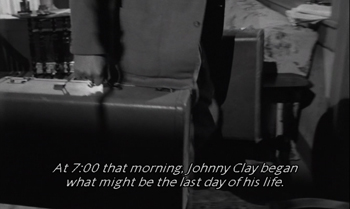 |  |
Shot 137 | Shot 138 |
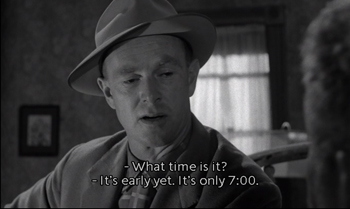 | 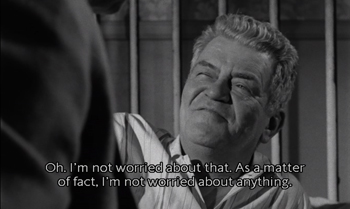 |
Shot 139 | Shot 140 |
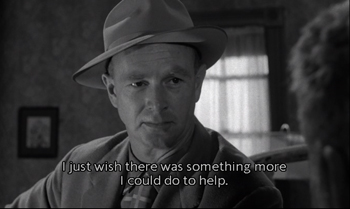 | 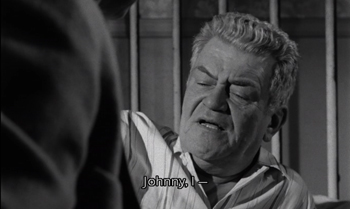 |
Shot 141 | Shot 142 |
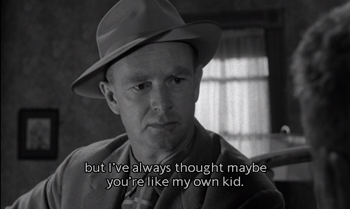 |  |
Shot 143 | Shot 144 |
 | 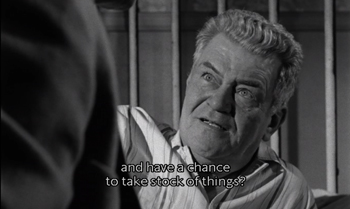 |
Shot 145 | Shot 146 |
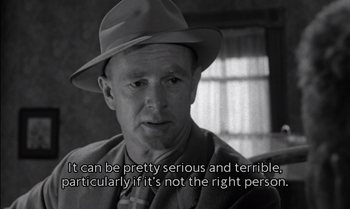 |  |
This conversation, none of it, occurs in the book. Johnny doesn't wake Marvin up to say goodbye and thank you. Marvin doesn't tell him he's like his own kid. Marvin doesn't tell him that being a rich man can make a lot of difference, that he'll be meeting people of quality and substance, doesn't suggest that instead of Johnny getting married they go off together. So what is the inclusion of the conversation in the film about? Is Marvin a father figure? Or is he a potential lover?
In the book, Randy (likely jokingly) questions Johnny's sexuality when Johnny doesn't want to meet with Sherry and suggests Randy meet her instead.
"What are you trying to tell me?" Randy said. "You mean you don't want to meet the girl? My God, Johnny, those years up the river must have done someting to you after all. Anyone would take a crack..."
"You don't get the picture," Johnny said shortly. "In the first place, if you'd talked to her, you'd realize that she's wide open. Anybody can take a crack at her. I don't want to go into details; I just think I'm the wrong guy for the job. There's too much on my mind."
I don't read the book as suggesting Johnny is gay, but this may have been used as a jumping point. Why throw it into the story in 1950s America? What effect was it supposed to have as regards the audience? And as for the characters, does this discussion end here with shot 146 and not have any repercussions? That's what I've been thinking about as I work my way through the movie. Later I discuss how Johnny was doomed to failure by the Production Code. He could not win, so fate must conspire against him and he must make mistakes. But I also wonder about the repercussions of this discussion on Marvin and Johnny in the film.Johnny doesn't get mad at Marvin for telling him Fay might not be right for him. He doesn't defend Fay. Johnny gently rebuffs Marvin by ignoring what he's said and tosseling his hair, as in, "I'm still fond of you, let's not go there." But think about it, Johnny's reserves on all levels (physical, emotional) are already stretched tight as this is a damn big day, the day that they're pulling off a two million dollar heist. And we should perhaps consider that one of the reasons Johnny ends up making the catastrophic mistakes that he does is due this conversation. (That and the production code.) Guilt, I believe, ends up overtaking Johnny later.
It could be that Johnny has been aware of Marvin's affection. It could be they are sexually involved. They appear to share the same bed. Kubrick leaves that question open.
It could be that Johnny, aware of Marvin's love for him, has used Marvin, and is now simply ditching him. Kubrick leaves that question open.
When Johnny and Sherry were on the bed, the background tended to be the footboard behind Sherry. Even when Johnny was shown, the camera was then filming through the footboard and the bars were black against the scene, framing Johnny, the headboard dim in the background.
In contrast, with Marvin the background is emphatically the white bars of the headboard behind him. When Johnny is shown, it is from behind Marvin but we don't see the headboard bars.
Shot 93 | Shot 94 |
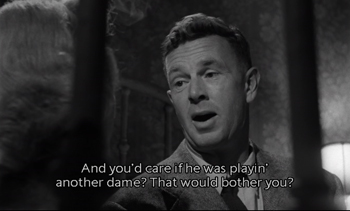 | 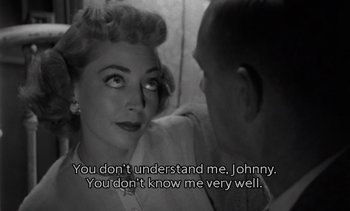 |
Shot 143 | Shot 144 |
 |  |
147 LS Airplane. (43:03)
NARRATOR: It was exactly 7:00 a.m. when he got to the airport.
Crossfade to shot 148.
148 CU Ticket. (43:06)
To MS Johnny at the counter.
AIRPORT CLERK: The weight is okay, Mr. Preston. Is that all the baggage?
JOHNNY: Well, I'll have one more with me tonight. I can keep it with me in the cabin, can't I?
AIRPORT CLERK: Yes, sir, but be sure and check in here at the counter prior to flight time. Flight 465 leaves at 9:00 p.m. tonight.
JOHNNY: Thank you.
AIRPORT CLERK: Thank you for flying American, sir.
Crossfade to shot 149.
Shot 147 | Shot 148 |
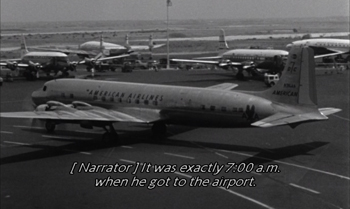 |  |
Timeline errors begin to enter. This is the first. I've read that, supposedly, the errors were intentional as Kubrick was against adding in the voice-over. I can't find a source for this however. And was it likely Kubrick would do this to a film? Someone who is known as being so attentive to his details, is it likely that he would toss in errors for no other purpose but out of needling rebellion? He does have in his films what many suppose to be goofs, and yet they aren't, they are purposeful, so the question is are these "errors" in line with other such "goofs"?
The film reached its halfway point in the prior scene, when Marvin is telling Johnny he is going to be a "new man" if things work out. We have just had, prior this, Red Lightning being given a half portion of feed. It is after the critical conversation with Marvin that we have the timeline "goof" of two scenes occurring at 7 am. Johnny is both speaking with Marvin and is at the airport checking in luggage. In the chess club scene we already had the mirroring, and we had inversions in the scene with Nikki. One could look at these two scenes occurring at 7 as another form of doubling, but of course these are activities that can't be happening simultaneously.
There is another conflict here. Johnny is said to be flying American flight 465 that evening at 9. Yet in shot 376 he will be given as waiting to board American Airlines Flight 40.
Which brings in actually another mirroring. He's flying American Airlines, the logo of which is AA with a bird flying between the two As.
Marvin was advertised for the film as being a reformed alcoholic. What does that mean? More than likely that means he was reformed through AA. More implicit doublings.
In the book, the only thing Johnny does between leaving his hotel and going to the race track is to go to the airport. He leaves for it at 11. He checks his suitcase, eats. He leaves at 1 p.m., in a cab, for the racetrack. He is at the track by 1:40. He gives the cabbie $10 and tells him he'll give him another $10 if he'll wait around for him. In the book, Johnny is able to escape the chaos of any traffic jam because he's had the cab wait for him. The cab driver has parked to the rear of the lot and they are able to leave almost immediately. This doesn't occur in the movie but the fact this happens in the book reminds of Eyes Wide Shut and Bill asking the cab that drove him to Somerton to wait for him, tearing a $100 bill in half and promising him the other half when he returns.
We'll see in a later scene that the Chess and Checkers Academy is closed 2 hours a day, from 7 to 9 a.m. To me this seems significant that this time error occurs at 7 a.m. The Chess and Checkers Academy has been associated with doubling and mirror reversals, but it is also presented as a place of working out logic, in which Maurice (Maurice Cohen in the book) dispenses logical and philosophical advice in the film. He is an oracle of sorts. Examining a chess game he is able to state what moves have been missed and project what is going to happen.
At least in the early 50s, the Chess and Checkers Academy in NY, on which this one was based, was instead open 24 hours a day, 7 days a week. At least that's how it ran while it was under Joe Fursa. I don't know about when it was under Harold Fisher. The movie has Fisher as running this club.
149 Johnny's car arriving at the motel. (43:27)
NARRATOR: Stopping first at a florist, he arrived at the motel at 8:15.
150 MS Johnny climbing out of his car with a florist box. (43:31)
NARRATOR: He was on schedule.
JOE: Good morning, my friend.
JOHNNY: Good morning, Joe. Now, look. This afternoon a friend of mine is stopping by and leaving a bundle for me. He's a cop.
JOE: A cop?
JOHNNY: Yeah, yeah. He's, uh, drives a prowl car.
JOE: A funny kind of friend that you have.
JOHNNY: He's a funny kind of a cop. Now, you let him in, huh? He'll leave this bundle for me about 6:30. I'll be by right after that and pick it up, and that's the last you'll see of me.
JOE: Would you come in for a drink?
JOHNNY: I'd like to, but I got a lot to do today and if I did that, why, everything would be all fouled up.
JOE: I understand. I'll see you tonight.
JOHNNY: Yeah.
JOE: So long. Take care of yourself.
Johnny goes down to his cabin.
151 The cabin door opening from the interior. (44:10)
Johnny takes out the violin case. He takes a gun out of it and puts it in the florist case under the flowers. Crossfade to shot 152.
Shot 150 | Shot 151 |
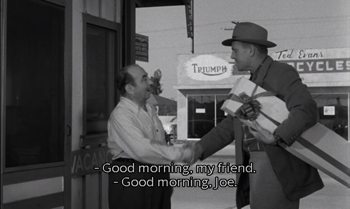 |  |
I write about these doors of the cabins in section 2. I'll give the images pertaining to this segment again here.
Johnny's second visit to the cabin is at 8:15 Saturday morning.
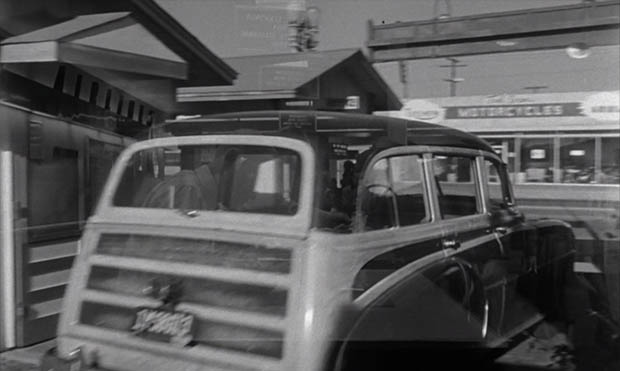
Shot 149 shows the cabin next to the office has its screen door, as with in shot 125.
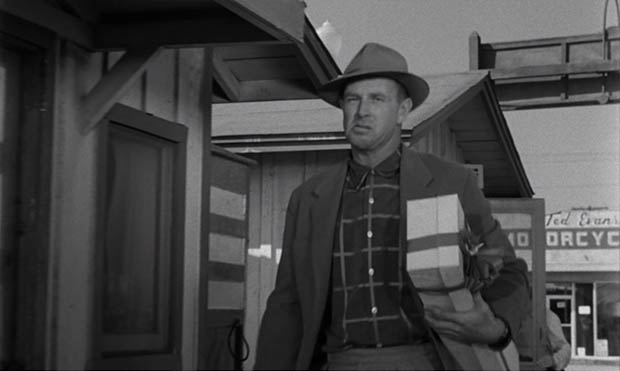

Shot 150 shows there is now no screen door on the cabin next the office.
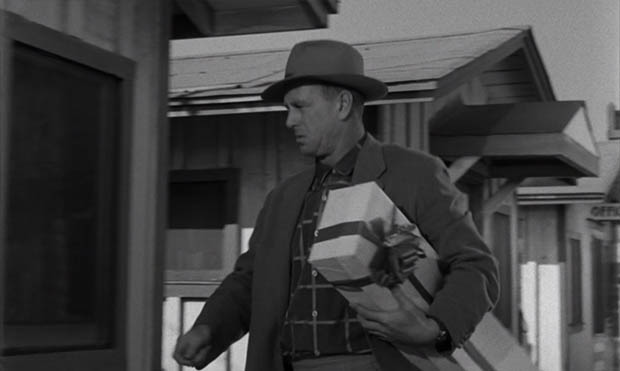
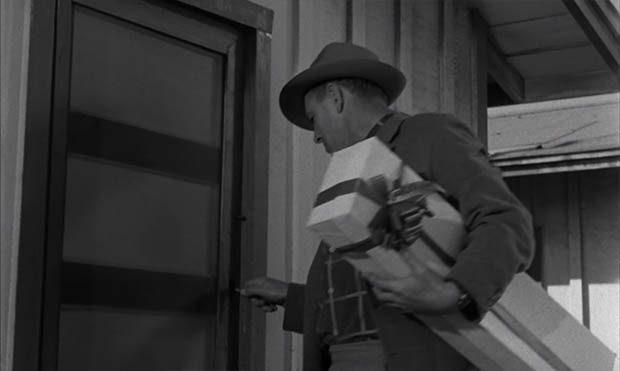
In the same shot we see Johnny uses his key on his door as if it has no screen door, and yet the door looks like it may have the covering of the screen door.
That bugs me. Those doors bug me.
To return to the subject of the "eavesdropping". I had mentioned previously the person who briefly appears outside Johnny's cabin when he is putting the violin case/gun away in the dresser drawer during his first visit to the cabin.
Let's take a look at the cabins again. The cabin between the office and Johnny's is different from the rest. How is it different? It has an extra little eave extended over the porch which you can clearly see in shot 150.

No other cabin has this and I wonder if it refers to the eavesdropping.
After the heist, Johnny returns to the motel and will accidentally try to open the door of that cabin neighboring him. Imagine being inside that cabin. It recalls Sherry's thumping accidentally Marvin's door and being found eavesdropping. The eavesdropping forms a theme that I will briefly explore further in the 4th section.
I may as well go ahead and write some about Ariel now. Fear and Desire borrows much from The Tempest, and one thing it explicitly borrows is a song sung by Ariel, a powerful spirit, able to manifest illusions, that is held in servitude by Prospero. The character of Sidney is the one who becomes aligned with Ariel. When he is left by the others to stay with a young woman they've found and bound to a tree, he paraphrases for her Ariel's song, but he does so erroneously. The song was sung for Ferdinand, the king's son, when he assumed his father had died in a shipwreck that was only an illusion manifested by Ariel. Hearing this song, Ferdinand follows it, and feels it confirms for him that his father is indeed dead. Sidney instead tells the woman the sung was sung for Miranda, Prospero's daughter, relating to her that her father was dead. He's in error here. At the end of Fear and Desire Kubrick again has Sidney singing the song as he and Mac float down the river on their raft.
Why make this error? I explore this at some length in the Fear and Desire analysis and won't repeat what I've written there, but what happens does set precedent for HAL's error in 2001 as it ties into a chess game at the end of The Tempest.
What is curious to me about Kubrick placing a reference to Ariel opposite these cabins--by his choosing this cabin motel, across from the motorcycle shop, to be a set--is that he seems to be connecting the intentional "error" in Fear and Desire with an error that was made in Clean Break, the book upon which The Killing is based. As I wrote at the top of this section, at Joe's rooming house Johnny does not transfer the gun from its suitcase to the florist box. Instead, he leaves with a suitcase, goes to Penn Station, and puts the suitcase in a locker for Mike. The next day, Mike takes the key he's received the previous day, by messenger service, goes to Penn Station, and removes a florist box from the locker.
Johnny found a cab on Second Avenue and told the driver to take him to Penn Station. He carried the suitcase into the lobby and found the bank of steel lockers. Checking the suitcase, he took the key and put it in an envelope. That night he had a messenger service drop it off at Big Mike's apartment.
But when Mike goes to the locker there is instead a florist's box.
He left the subway at Penn Station, but instead of going downstairs to the Long Island division, he went up to the main lobby. He found the bank of steel lockers exactly where Johnny had told him they would be.
Carefully he looked around after locating number 809. He saw no one he knew.
Mike took the key and inserted it and turned. He pulled the door open.
It was a florist's box, about three feet long, twelve inches wide and eight inches deep. It was beautifully wrapped and tied with a large red ribbon. There was only one thing wrong with it. It weighed about twenty-five pounds.
The author says, "There was only one thing wrong with it..." It weighed 25 pounds.
But, no, there was more wrong with it than that. The author seems to have been pointing out for us that there WAS something wrong with that box. The author seems to be asking if the reader is paying attention? There was something wrong with that box in that Johnny left a suitcase not a white florist's box with a red ribbon.
Maybe this was instead an error overlooked by everyone in the editing phase of the book, but I instead have the feeling the author was pointing out a deliberate error. And I have the feeling that Kubrick picked up on it and pulled it into the movie, and how we know he pulled it into the story is his placing it in proximity of Ariel.
152 From within the bus station, a bus pulling out. (44:38)
As the bus leaves, Johnny's car pulls up and parks. He enters the station.
NARRATOR: He reached the bus station at 8:45.
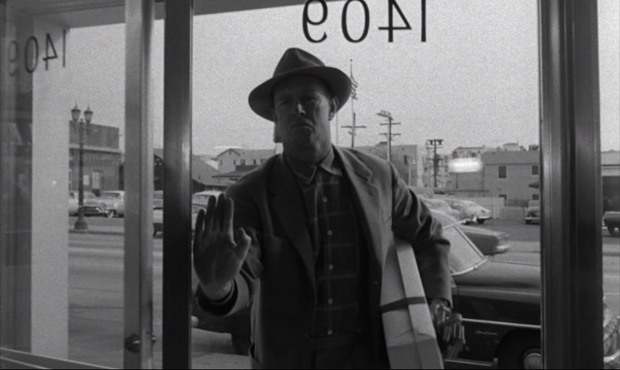
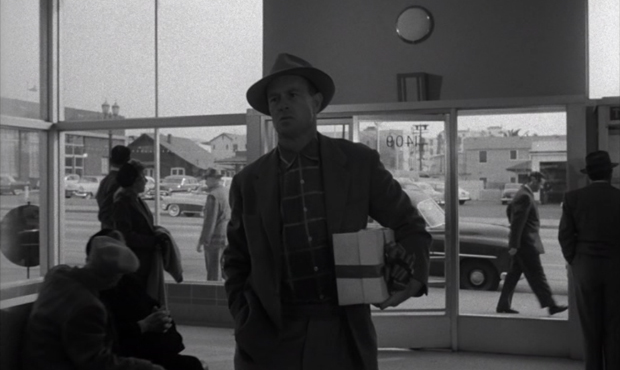
Johnny goes to a locker and puts the florist box in it. As he exits crossfade to shot 153.
This is the old Greyhound bus station at 1409 Vine Street in Los Angeles, which is no longer there.
The locker the gun/florist box is stored in is locker 45. 504 is the number of the building where Marvin's apartment is, and we had 504 and 405 associated with the targets at the rifle range at Nikki's where Johnny received this rifle.
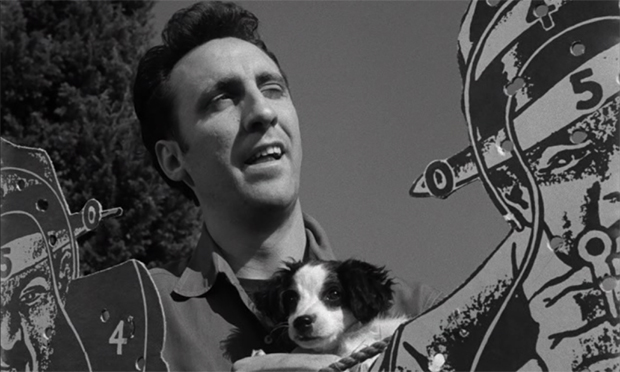
153 LS Johnny leaving his car and going up to the post boxes at Mike's apartment. (45:16)
NARRATOR: It was 9:20 when he arrived at Mike's apartment. So far, everything had gone off according to plan.
154 CU Johnny deposits a key in the post box. (45:23)
155 MS Johnny leaves the building, returning to his car. (45:25)
Shot 153 | Shot 154 |
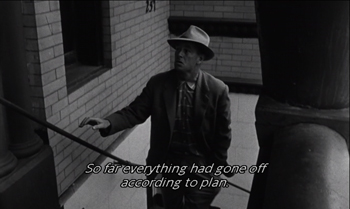 |  |
Shot 155 | |
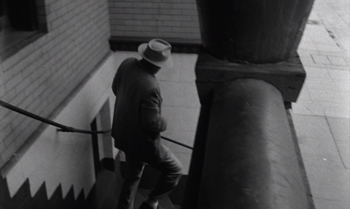 | |
Mike's building's number is 257. No one has identified where it is and I imagine it was probably on Bunker Hill in LA and is long long decades gone.
In the book, Johnny does not go to Mike's place, instead he sends the key Friday night by messenger service.
156 MS Mike pulling on his jacket in his apartment. (45:16)
NARRATOR: Mike O'Reilly was ready at 11:15.
MIKE (sitting down with his wife on her bed): What goes on here? This is no way to get your strength back.
RUTHIE: Oh, it's very good, Mike, but I guess I'm just not hungry. Really, I couldn't eat another bite.
MIKE: Another? You haven't eaten anything yet.
RUTHIE: Well, I'll take something after a while, after I've had my medicine. I'll have more appetite then.
MIKE: That's a promise. No tricks now.
RUTHIE: It's a promise. You better go along now, Mike, or you'll be late for work.
MIKE (rubbing her hand): Yeah, I guess I will. Ruthie, things are gonna get much better for us.
RUTHIE: I know. I know, dear.
MIKE: I know I've made a lot of promises in the past, but this time it's not just talk. We're gonna be rich, and soon. You're gonna have a fine house and doctors that'll make you well again.
RUTHIE: Of course, dear. But you'd better go along, or you'll be late.
MIKE: Yeah.
He stands to exit into the front room, the camera following him to the door.
RUTHIE: Oh, Mike.
MIKE: Yes?
157 MLS Ruthie in her bed. (46:26)
RUTHIE: On your way home tonight, would you bring me some magazines?
158 MS Mike. (42:27)
MIKE: Of course. But, uh, Ruthie, I'm going to be a little late. Probably about 10. Some of the fellas and me are having a little get-together.
159 MLS Ruthie in her bed. (46:36)
RUTHIE: I understand. But don't you drink too much beer, Mike. Remember how it always leaves you the next day.
160 MS Mike. (46:42)
MIKE: Don't worry about that. I won't be doing any drinking tonight.
161 MLS Mike in the front room. (46:50)
MIKE: I called mother. She'll be over this afternoon to fix your dinner.
162 MLS Ruthie in her bed. (46:36)
RUTHIE: Thank you, dear. (She airmails a kiss.) Goodbye.
163 MLS Mike at his front door. (46:56)
MIKE: Don't forget to eat your breakfast.
He exits.
164 Front door of the apartment building from outside. (47:01)
Mike exits.
165 CU the post box. (47:05)
Mike takes the key left by Johnny and his mail, two envelopes, from the box.
Shot 156 | Shot 157 |
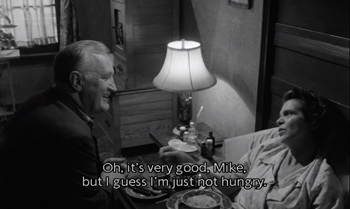 |  |
Shot 158 | Shot 159 |
 | 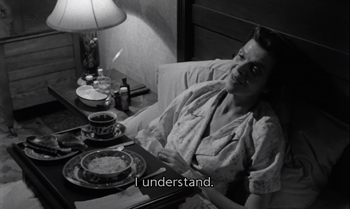 |
Shot 160 | Shot 161 |
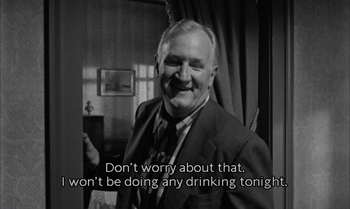 |  |
Shot 162 | Shot 163 |
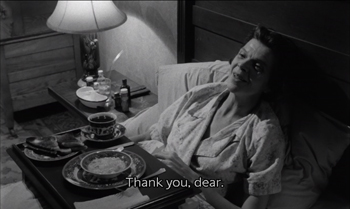 |  |
Shot 164 | Shot 165 |
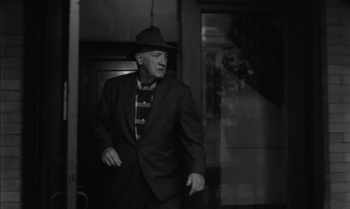 | 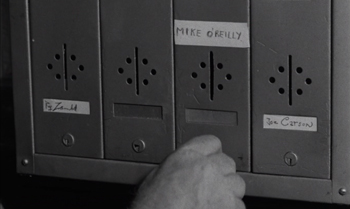 |
166 MS Mike leaving his building. (47:12)
He crosses the street to his car. Crossfade to shot 167.
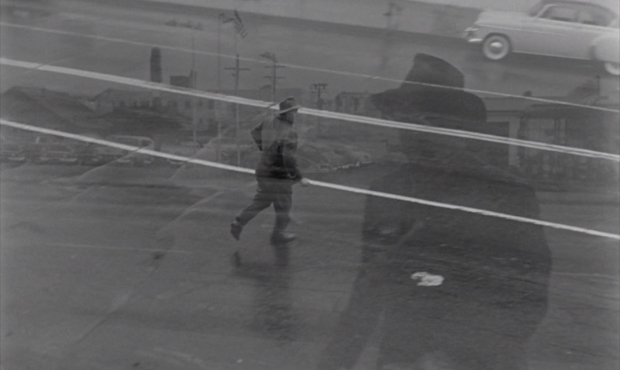
Poor Ruthie. Mike wants to go out after work? She understands. She doesn't complain. She just doesn't want him to drink too much, which means maybe Mike has a bit of an alcohol problem. He probably is always telling her how things are going to get better. In the book, he bet on the horses. His hope was that one good win would day make them money. It never happened.He's down at the track every day listening to people win and lose on the races and he sees winners every day but never gets a big win himself. Perhaps he has a gambling problem. But it's evident, from the way Kubrick presents him, that he loves Ruthie. He wants her to get better. He doesn't want to lose her. Poor Mike. Sherry and George's apartment is essentially Sherry's boudoir, which is fine for Sherry, in keeping with Sherry. Mike and Ruthie's set has been decorated so as to represent a home. A modest little apartment that is a nicely maintained home for Mike and Ruthie. We've the feeling that they likely don't have children, and no one else to to rely on other than Mike's mother. Sherry and George are less a family than two people at war with one another. Ruthie and Mike are a family. Ruthie and Mike care for each other. We're supposed to feel sorry for them. We do.
167 MS Mike entering the bus station. (47:21)
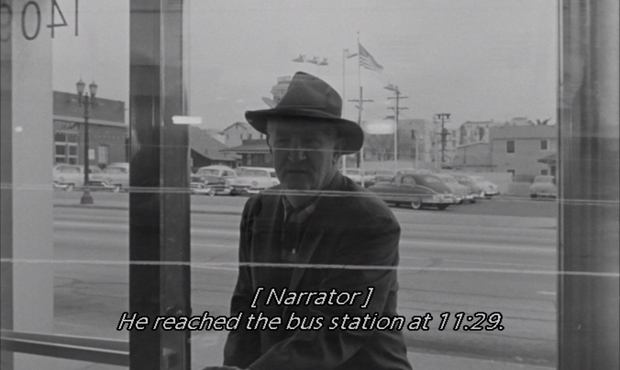
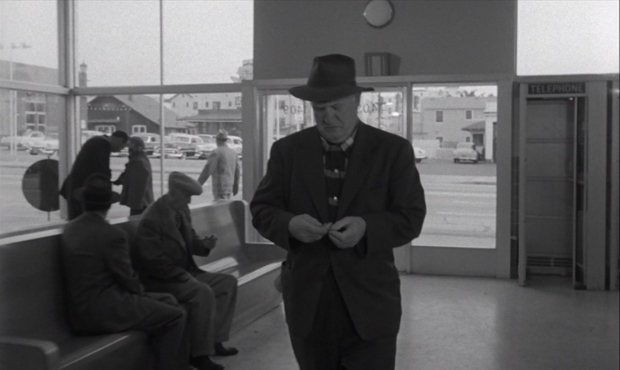
NARRATOR: He reached the bus station at 11:29.
Mike goes to the locker and takes out the florist box then leaves by the side door, catching the "Race Track Special" bus just in the nick of time, its doors having closed.
I think the man on the bench in the cloth driving cap was also there when Johnny went through, but he was with a woman.
Crossfade to shot 168.
In the novel, Mike doesn't nearly miss his train. In the movie, he almost doesn't catch the bus, having to beat on its window. Of course he could have taken a taxi, but the point is made. Every step is planned, scheduled. But what of luck and bad luck? What if bad luck intervenes and throws off all that careful planning?
168 Another bus, 65, at the track, women exiting. (47:52)
169 LS of Mike through a window, arriving at the track and checking in. (47:56)
NARRATOR: At 12:10, as it was his custom, he arrived at the track.
170 MLS Mike going down a hall to the locker room. (48:02)
171 MS Mike, from inside the employees locker room, entering. (48:05)
He passes behind two banks of lockers. Goes to his locker in the third bank and places down the florist box on a bench. One man whistles.
EMPLOYEE: Well, what do we got here? Who's the girlfriend, Mike?
2ND EMPLOYEE: That's how you spend your money, blowing your money on dames. An old man like you ought to know better.
MIKE: I ain't like you guys. These posies are for my wife. Besides, where do you guys...
172 MS George elsewhere in the locker room dressing, listening in. He takes a gun out of his lunch box and loads it. (48:25)
MIKE (off screen): ...get off calling me an old man?
EMPLOYEE (off screen): Why don't you buy your flowers after you get off work, Mike? Liable to wilt on you before you get home.
MIKE: Well, it can't be helped. After work the shops will all be closed.
2ND EMPLOYEE: Why don't you take them out and put them in some water? Or probably the clubhouse steward would put them in the refrigerator for you. Why don't you do that?
MIKE: Well, perhaps I should.
173 MLS Mike in the locker room. (47:43)
MIKE: But, well, it's getting kinda late now...
EMPLOYEE: I'm all dressed. Why don't I do it for you?
MIKE: No.
EMPLOYEE: What's the matter, Mike? I was just trying to do you a favor.
MIKE: These flowers are going in my locker. Then I'll know where they are.
EMPLOYEE: Okay, Mike, suit yourself.
MIKE: I'm sorry, Bill. I appreciate your offer. But after work you know how it is. Everybody will be in a hurry to get away and...
Bill angrily slams his locker door and leaves with employee #2.
174 MS George. (49:12)He exits.
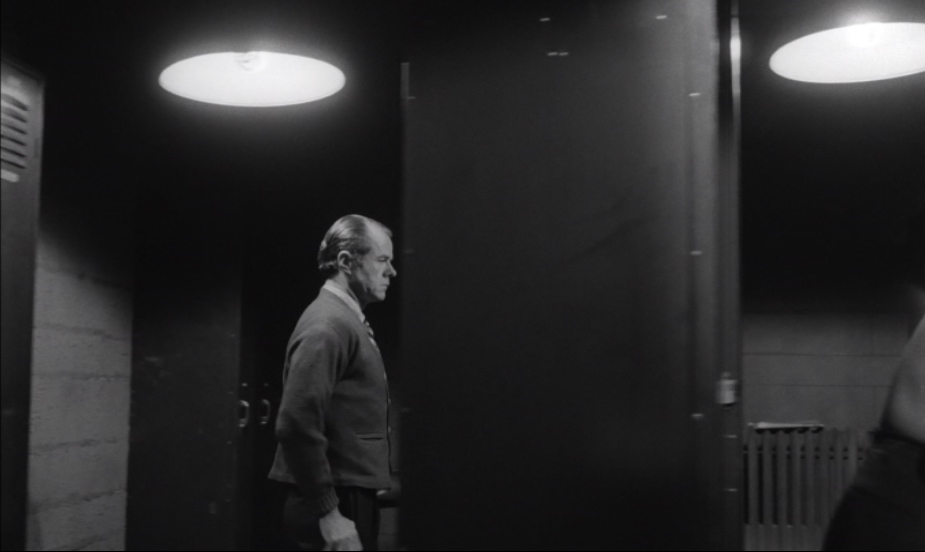
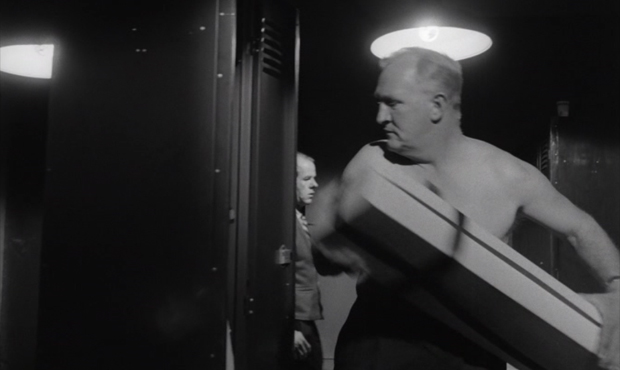
175 MLS Mike at his locker. (49:27)
Mike listens to George exit. Fade to black.
Shot 168 | Shot 169 |
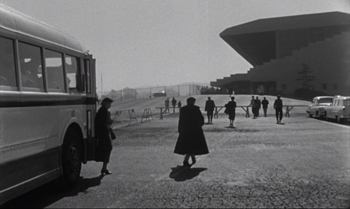 |  |
Shot 170 | Shot 171 |
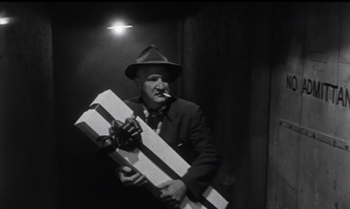 |  |
Shot 172 | Shot 173 |
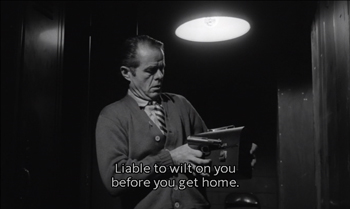 |  |
Shot 174 | Shot 175 |
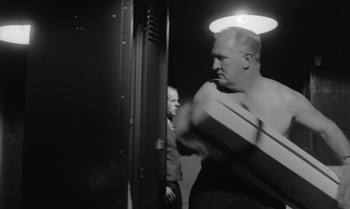 | 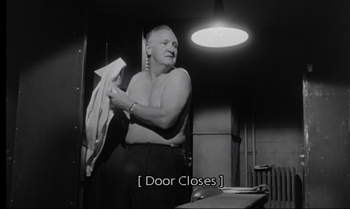 |
176 MLS Mike exits as security arrives. (49:42)
Mike exits and the door opens across from the employees dressing room showing the room where the money is kept.
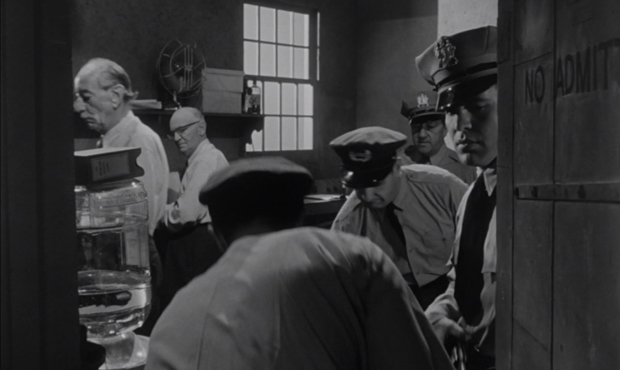
The door shuts and the camera swings back to show Mike standing under the lamp at the end of the hall. As he exits, crossfade to shot 177.
In the novel, no one questions Mike about the florist box. He has no problems at all. In the film, Mike has done something unusual by purchasing flowers for his wife and bringing them to the track. That this is unusual for him is the human error factor. There was risk involved in that notice might be taken. One of the men is already dressed and willing to take the flowers to be placed in water to preserve them. Mike is terse and unable to come up with a satisfying reply as to why he doesn't want to put the flowers in water. If the robbery hadn't ended in falling apart, then one can imagine he might have been later remembered as behaving oddly and questioned. But one has the feeling that he is also a guy who is well liked by everyone--which is one of the problems with his becoming suddenly terse and nervous and behaving out of character. No one expects Mike to get upset and he does. This is different. They're going to take note.
Meanwhile, we have our first look, in the film, at George and his gun. The guy is determined to be trouble. Sherry has led him to believe that she was assaulted by Johnny, so he has every reason to be upset. George, with that gun, is a problem we worry is going to go off against Johnny, but not until after the heist. And then what? When does he think he's going to confront Johnny? If everything went as planned, and he killed Johnny afterward when, say, collecting his part of the money, that would certainly put a kink in things--attention-getting gunshots and a dead body..
177 Loudspeakers. (49:46)
ANNOUNCER: ...is third, and Comfort King.
Shot 177 is the same as 193 (horses are running the 7th as Randy arrives), 200 (horses are readying to run as Maurice arrives and goes to the bar), 253 (the horses are coming on the track for the 7th as Nikki watches), 257 (right before the horses are at the starting gate, Nikki watching), 282 (horses on the track for the 7th as Johnny enters and passes by George), 285 (the horses approaching the starting gate as Johnny goes and stands at the bar by Maurice).
178 Flags. (49:49)
ANNOUNCER: It is My Baby leading by a length.
179 Race horse 3. (49:52)
ANNOUNCER: Concentrator is second, by three quarters of a length. Second Ending, moving up fast now on the outside, is third, and Comfort King. It is My Baby, Concentrator and Second Ending. It is Second Ending, Concentrator and Comfort King. It is Second Ending in front. Down to the wire it's Second Ending the winner by a half a length. Concentrator second by two...
180 The crowd. (50:14)
ANNOUNCER: ...Comfort King third and My Baby.
181 The horses. (50:17)
ANNOUNCER: The result of the first race now appears on the totalizator board. Be sure to hold all tickets until the result of the race is declared official.
Crossfade to shot 182.
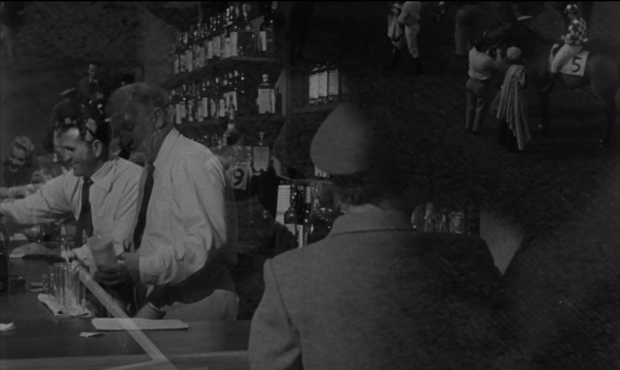
182 MLS Mike serving. (50:29)
ANNOUNCER: After the first race, Mike was very busy.
Mike finishes serving two individuals then his face frowns with concern. He sees a drunk Marvin ambling through the crowd.
183 Mike drunkenly makes his way to the bar through the crowd. (50:29)
MIKE: Give me a double bourbon, please.
184 MCU Mike. (50:43)
MIKE: Don't you think you've had enough, pal?
Shot 177 | Shot 178 |
 | 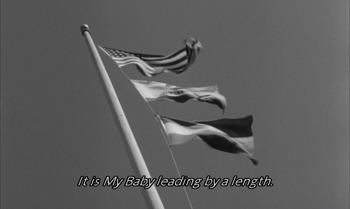 |
Shot 179 | Shot 180 |
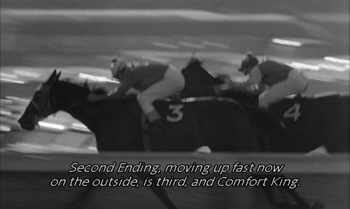 |  |
Shot 181 | Shot 182 |
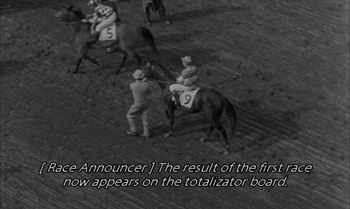 | 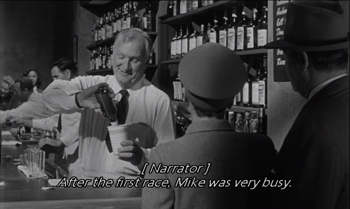 |
Shot 183 | Shot 184 |
 | 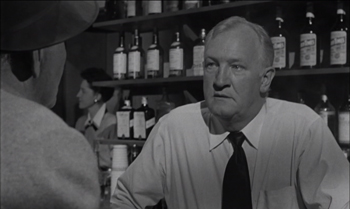 |
185 MS Marvin winks at Mike. (50:48)
He turns and wanders drunkenly away.
ANNOUNCER: Your attention please. The horses are now on the track for the second race at six furlongs.
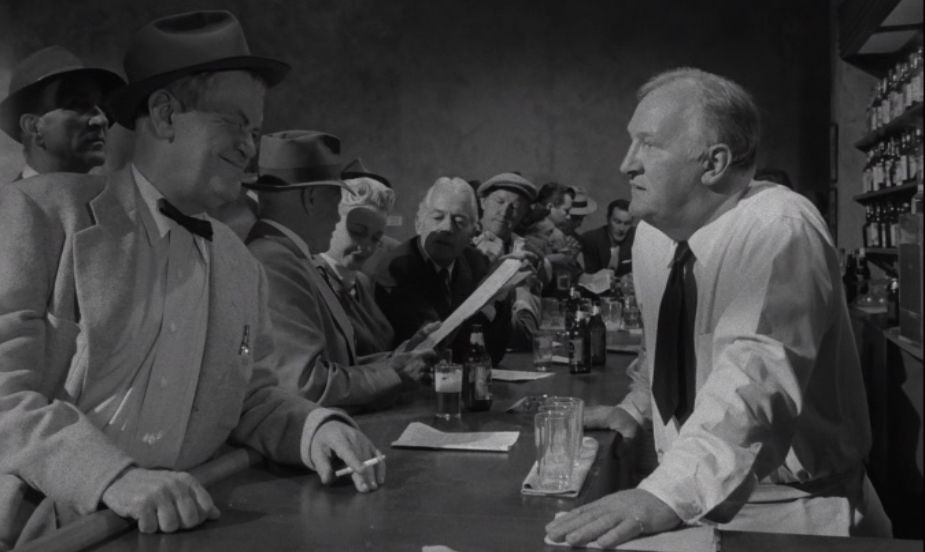
Johnny's plan was that Marvin should not show up at the racetrack. He should go to a movie. Well, ironically, he is at a movie. And it's with this plan, Johnny telling Marvin to go to the movie, that we begin to have the split at 7 a.m. in which the timeline doubles so that we have Johnny doing two things at once. The split is continuing, Marvin appearing at the racetrack, and will perhaps be a reason for a peculiar thing that happens when Marvin later, because he is there, rescues Johnny.
Anyway, I think we need to take this into serious consideration as far as it being a step beyond the 4th wall, Marvin having gone to a movie (by virtue of being in one), and that we have split into two parallel stories. In one we have everything being experienced subjectively. In the other, the story has stepped outside itself, and is to some extent self-aware, self-conscious, watching itself, aware of its relationship to the audience. This may sound absurd but it happens in Killer's Kiss when Davey's manager agrees to drop off Davey's money before he goes to the theater with his wife, and then ends up in an alley outside a theater, mistaken for Davey by a couple of thugs, and is pleading with the audience that he can hear in the theater, begging for help, to be let in. Commenting on this is the ad for Himberama that is seen when the manager arrives at the dance hall where he is mistaken for Johnny. The ad for Himberama promises a 4D experience, immersive. Dissolution of the barrier between stage and audience. If one refers back to Killer's Kiss I discuss this at length in that analysis and in a separate post.
There are also parallels with the story of Pagliacci, in which he puts on his mask for a play but then we have both the play and real life intertwined and occurring simultaneously. George may be the one explicitly identified as Pagliaccio, and most closely resembles that character, the jealous husband betrayed by his wife, but Marvin also is a kind of Pagliaccio character. He revealed his real affection for Johnny and warned Johnny that he might be marrying the wrong person. One reason we're aware that Johnny understands this was likely not a father figure speaking to a son substitute is in the way he ignored what Marvin said. When Johnny suggests Marvin go to a movie, Marvin now becomes also a betrayed Pagliaccio, rejected by Johnny, losing him to Fay. He has gone out of bounds, as with Pagliaccio, and Mike and Johnny, also role-playing for the heist, actors in this "play" they are putting on, must contend with him as did the actors in Pagliacci attempt to deal with the drunken Pagliaccio.
CANIO
No, I am not Pagliaccio! Although my face
is white, that is for shame and for the lust
for vengeance! The man reclaims his right,
the heart that bleeds wants blood to wash away
the shame, damned woman! No, I am not
Pagliaccio! I am he, I am that fool who found you,
a starving orphan of the street,
and took you in, and offered you a name,
and the fever and the folly of his love!
WOMEN
Friend, it makes me weep,
so true the play appears!
Source: http://www.murashev.com/opera/Pagliacci_libretto_English_Act_2
Recollect that in the book Marvin never has the conversation with Johnny in which he suggests they go away together instead of Johnny marrying Fay. His character has stepped out of the novel's bounds. He is very much like Canio, having taken in Johnny, having believed in him, bankrolling him, Johnny living in his home, but now he is to lose Johnny to Fay. Marvin becomes the wild card. And just as the (play-acting) audience in Pagliacci didn't know what was really going on, so too is the cinema audience left to reflect upon Marvin's actions and wonder, "Did he really say to Johnny what it seems he was saying? What happened?" The audience must wonder, too, is he really drunk, or is he just pretending to be drunk as his wink suggests?
In the book, before the robbery commences, Marvin steps into a highly objective place and analyzes what will happen based on his knowledge of the men involved and human nature. He, too, in a sense, becomes a part of the audience, knowing more than the characters, but not knowing or being able to anticipate everything. He is the one person in the book who, before the robbery, erases his presence, sells everything he has, planning to disappear. He would listen to the race on the radio then realizes he even sold his radio. On the day of the heist he goes to the track to watch the action from the stands, like a member of the audience. Knowing this, does Kubrick have Marvin at the race track a a member of the audience?
186 Randy leaves a soda fountain/cafe and goes to a police call box. (50:58)
NARRATOR: At exactly 3:32 that same afternoon Officer Randy Kennan set in motion his phase of the operation.
RANDY (making a call): Hello, Fred. This is Randy. Listen, pal, will you check with the dispatcher's office and see if they've been getting me loud and clear? I think my set's a little on the blink. Sure. (He glances at his watch.) Huh? What? He says it's okay? Well, that's funny. It keeps going dead. No, I don't think it's one of the tubes. I'll keep fooling around with it. Give my regards to your Mrs. By the way, when's the big day supposed to be? Well, don't worry about it. The sixth one is always the hardest.
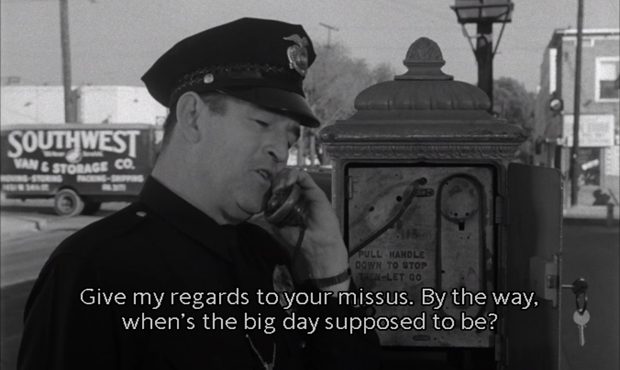
Randy hangs up and goes to his car. A woman comes running from across the street.
WOMAN: Officer! Officer! Oh, thank heaven. Hurry! Come quick! They're killing each other! I always knew they'd...
Randy drives off.
187 Street scene from above. (52:05)
NARRATOR: He had timed the trip to the track on half a dozen different occasions and he knew at just what point he should be at precisely what time. He knew the entire success of the plan depended on his accuracy in arriving at the track at exactly the correct moment. A minute or two early was allowable, but 10 seconds late would be fatal.
Crossfade to shot 188.
188 Loudspeakers. (52:20)
ANNOUNCER: Your attention, ladies and...
189 Race track security at check in. (52:24)
ANNOUNCER: ...gentlemen. The horses are now on the track for the seventh race. The $100,000 added...
Randy drives through, waving hello.
190 Loudspeakers. (52:20)
ANNOUNCER: ...Lansdowne Stakes at one mile.
Crossfade to shot 191.
191 The patrol car pulls up behind the track and parks. (The license plate is 2X37772.) (52:41)
Randy gets out and the camera pans up to an open window on the 2nd floor (there are 3 windows, the center one is open).
192 MS Randy standing beside the patrol car. (52:59)
ANNOUNCER: And they're off and running. At the start it is Red Lightning breaking on top. Early Streak is second...
193 Loudspeakers. (54:05)
ANNOUNCER: ...I'm Hoping is third, White Fire is fourth...
Shot 186 | Shot 187 |
 |  |
Shot 188 | Shot 189 |
 | 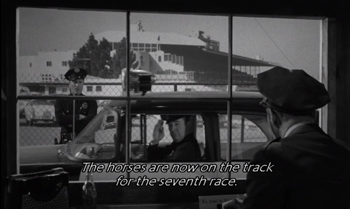 |
Shot 190 | Shot 191 |
 | 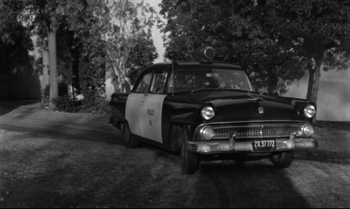 |
Shot 192 | Shot 193 |
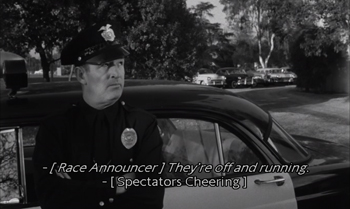 |  |
The woman running across to Randy's patrol car was filmed at 1307-1309 West 39th Street in LA. (The moving van labeled Southwest was going south down Normandie Avenue.) So we're in South Los Angeles at this point. (GaylordWilshire at skyscraperpage.com identified for themoviedistict.com this location)
With the aerial view, the police car is turning left, off the 200 block of Flower Street, onto the 700 block of 3rd St, then passing Cinnabar St. on the right which was a short narrow street that halved the block and ran between 3rd and 2nd. Randy continues on driving past it, which means he would next cross Grand Street. We can tell this because in the lower right corner of the shot you can just barely make out a Cinnebar Street sign.
Hmmm. Or he's turned off Hope St. onto the 700 block of 2nd and passes Cinnebar as he heads toward the 800 block?
Am I right? Am I wrong? Isn't that Cinnebar?
This is a map of Bunker Hill as it was before redevelopment.
In The Shining the characters are isolated from civilization by location and by a storm, the phones down, and Jack finally disables the radio so there is no communication. In 2001 HAL warns that a fault in the AE35 unit will cause it to fail in 72 hours. When it is found not to be faulty, HAL suggests it be put back in operation, allowed to fail, and the cause can then be tracked down, but it means being out of communication with Earth during this time.
We have a similar window of isolation in The Killing with Randy's phoning in that his radio is down. He reports that it is broken when it isn't.
In the book there is a little less emphasis on the broken radio part of the lie. Instead, the emphasis is on Randy having arranged for his usual supervisor not to be on hand, so that when the sub is unable to reach him it will be assumed to be/explained away as due a dead radio. In the movie, Kubrick streamlines and instead has Randy call in from a police phone that his radio is going dead.
The theme of maternity again enters. The 6th is said to be the hardest.
I wonder if the van driving through during this conversation is not a coincidence. Cardinal directions are used in both the novel and the film for placing where Nikki will be when he shoots the horse. Southwest is not used, instead he will be southeast in the northwest lot.
The sevens keep building up.
194 A man sweeping the Chess and Checkers Club. (53:09)
Maurice enters the shot from the rear, cuts left and then cuts right at the counter.
ANNOUNCER: Earlier that afternoon, at 2:30, Maurice was at the chess club. He was to be at the track in position at 4:00, just before the start of the seventh race.
MAURICE (going to the owner at the counter): Fisher...
195 MCU Maurice at the counter. (53:24)
MAURICE:
I am supposed to be back here tonight about 6:30. If I'm not, I'd like you to do something for me.
196 MCU Fisher at the counter. (53:27)
FISHER: Sure, Maurice. What is it?
197 MCU Maurice at the counter. (53:29)
MAURICE (takes a number from his pocket): I'd like you to call this number and ask for Mr. Stillman and tell him Maurice requires his services.
198 MCU Fisher at the counter. (53:35)
FISHER: Sounds pretty mysterious. What's it all about.
199 MCU Maurice at the counter. (53:38)
MAURICE: There are some things, my dear Fisher, which do not bear much looking into. You have undoubtedly heard of the Siberian goat-herder who tried to discover the nature of the sun. He stared up at the heavenly body until it made him blind. There are many things of this sort, including love and death and my business for today. Please remember to make that call if I'm not back at 6:30.
Crossfade to shot 200.
Shot 194 | Shot 194 |
 |  |
Shot 194 | Shot 195 |
 | 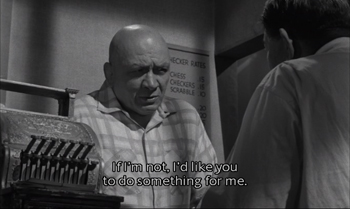 |
Shot 196 | Shot 197 |
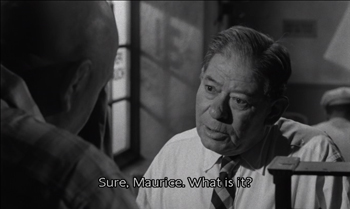 | 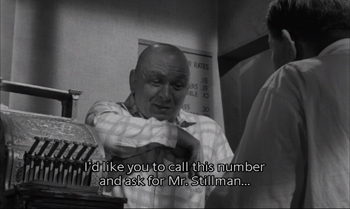 |
Shot 198 | Shot 199 |
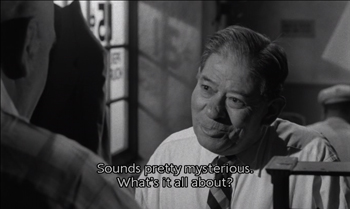 | 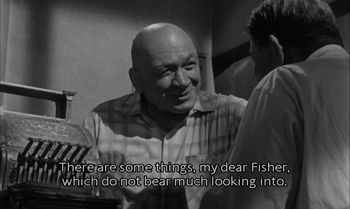 |
200 Loudspeakers. (54:00)
ANNOUNCER: Your attention, ladies and gentlemen.
201 Horses being led out onto the track. (54:05)
Shot 2 in the opening is the same as shot 201 and 254 and 283.
ANNOUNCER: The horses are now on the track for the seventh race, the...
202 The horses being led in a U-turn down the track. (54:08)
ANNOUNCER: ...$100,000 added Lansdowne Stakes at one mile.
203 The horses and riders parade down the track. (54:10)
ANNOUNCER: Your attention ladies and gentlemen. The horses are now on the track...
Shot 4 in the opening is from the same footage as shot 203 and 256.
Shot 200 | Shot 201 |
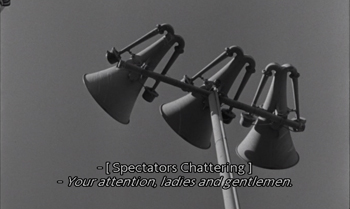 |  |
Shot 202 | Shot 203 |
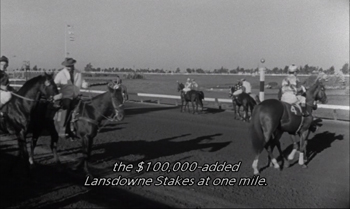 | 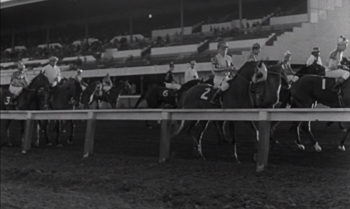 |
204 MS Maurice passes the cashier booths at the track. (54:17)
ANNOUNCER: ...for the seventh race, the $100,000-added Lansdowne Stakes at one mile.
Maurice strides purposefully to the bar.
MIKE: Yes, sir?
MAURICE: Bottle of beer.
MIKE: Yes, sir.
Maurice turns and faces the other direction, away from the bar, as we crossfade to shot 205.
205 Loudspeakers. (54:48)
ANNOUNCER: And the horses are approaching the...
206 The draft horses pull the gate into place. (54:50)
Shot 5 in the opening is the same as shot 206 and 258 and 286.
ANNOUNCER: ...starting gate for the seventh race. The horses are approaching the starting gate for the seventh race.
Crossfade to shot 207.
207 The horses being led into the gates. (54:59)
ANNOUNCER: The horses are at the gate.
Shot 7 in the opening is the same as shot 207 and 259
Shot 204 | Shot 205 |
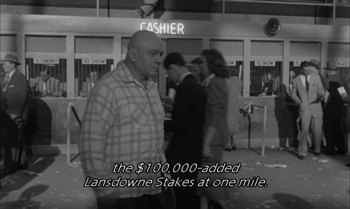 | 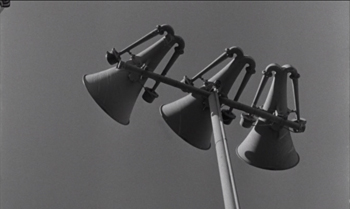 |
Shot 206 | Shot 207 |
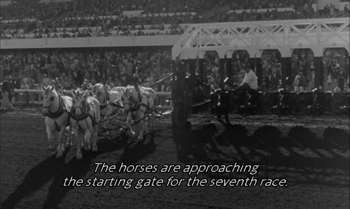 |  |
208 MS Maurice leaning against the bar. (55:04)
ANNOUNCER: The horses are at the gate.
Maurice glances over at Johnny.
209 MS Johnny leans next the NO ADMITTANCE door. (55:10)
210 MS Maurice leaning against the bar. (55:14)
He turns and faces the bar and slams his bottle down.
MAURICE: Hey! How about some service, you stupid-looking Irish pig?
MIKE (reaching out and pushing him): Hey, what's the matter with...
211 MS Mike being twisted about by Maurice and slung forward into the shelves. (55:24)
212 MS A woman blows a whistle. (55:25)
213 MLS Security comes up and grabs Maurice from behind. (55:27)
He throws the guard to the side and punches a bartender who grabs him. Another officer approaches and Maurice is grabbed by both.
214 MS Maurice wrestles two guards. (55:35)
215 LS Maurice and the two guards. His shirt rips in half. Another guard runs up and he twirls him on his back. (55:38)
216 A guard is thrown. (55:47)
217 MS of Mike behind the bar. He takes refuge in a cubbyhole. (55:48)
218 MLS of Maurice. (55:50)
219 LS of an officer rushing Maurice. (55:51)
He pushes him against the bar and a bartender cracks a bottle over his head. Maurice pushes him aside. Pushes an officer over the bar and is rushed by two others.
220 Low LS of Maurice flipping the two officers. (56:06)
221 LS of Johnny watching. (56:08)
222 MLS Bartender rushes Maurice and he throws him to the side. (56:11)
223 MLS Maurice throws an officer. (56:14)
224 LS the thrown officer. (56:16)
225 MLS the bartender rushing Maurice and head butting him in the stomach. (56:18)
226 Maurice falls back against the bar. (56:19)
227 MS George watches, silhouettes of fighters shadowing the screen back and forth. He slips out of the booth. (56:20)
228 MLS Maurice and two, four, five then six officers. (56:28)
229 MCU Maurice and the officers. (56:33)
230 LS of two officers exiting the NO ADMITTANCE door. (56:35)
231 MS Maurice rushed by the two other officers. (56:39)
232 LS Johnny beside the door. It opens and he slips through it. (56:40)
233 Maurice wresting the group of officers. (56:45)
They wrestle him past the No Admittance door.
GUARD: Come on. Break it up! Look out!
They push him past the cashiers booths and out.
Shot 208 | Shot 209 |
 | 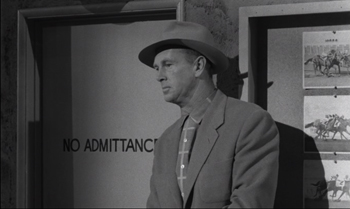 |
Shot 210 | Shot 211 |
 |  |
Shot 212 | Shot 213 |
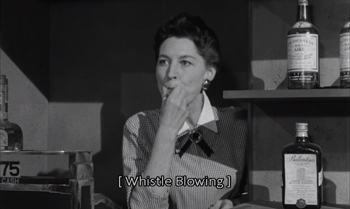 |  |
Shot 214 | Shot 215 |
 | 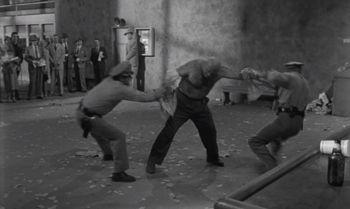 |
Shot 216 | Shot 217 |
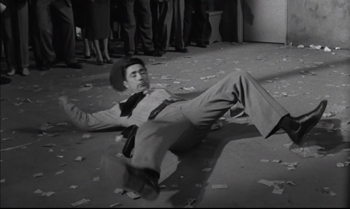 | 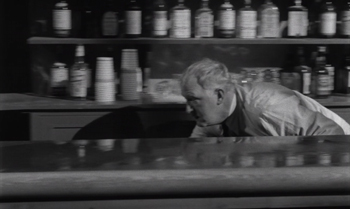 |
Shot 218 | Shot 219 |
 | 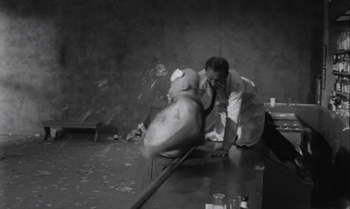 |
Shot 220 | Shot 221 |
 | 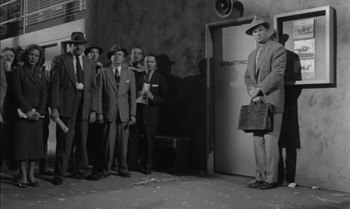 |
Shot 222 | Shot 223 |
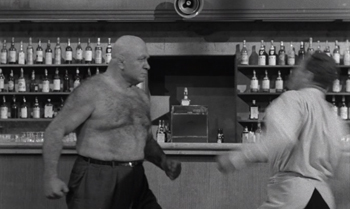 | 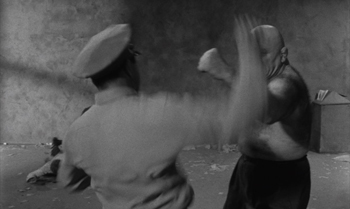 |
Shot 224 | Shot 225 |
 | 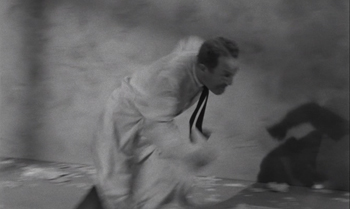 |
Shot 226 | Shot 227 |
 | 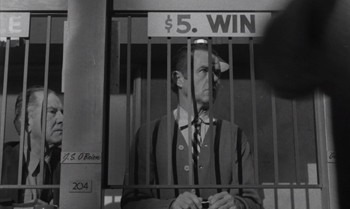 |
Shot 228 | Shot 229 |
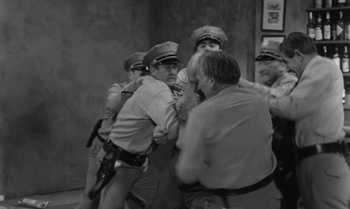 | 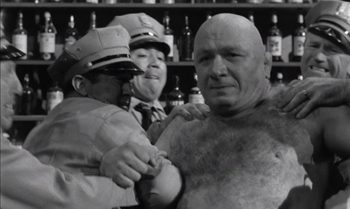 |
Shot 230 | Shot 231 |
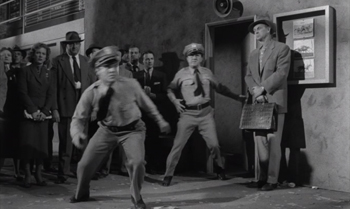 | 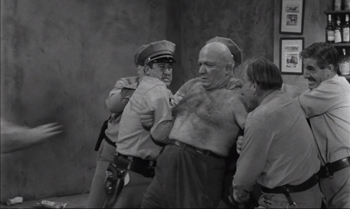 |
Shot 232 | Shot 233 |
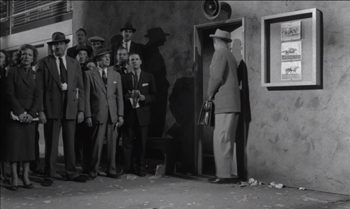 |  |
NARRATOR: It was exactly 4:23 when they dragged Maurice out.
Returning to the Chess Club we see a man sweeping, and it occurs to me how much the shadows here bring to mind those at the track.
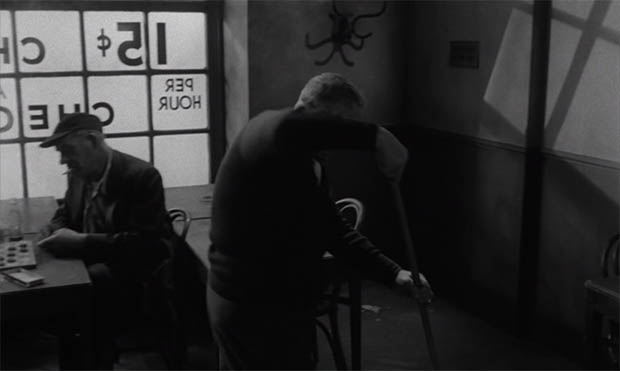

Not only that but we have the sweeper to connect both places.
Perhaps again tying together the chess club with the racetrack is that the chess club is based on the Chess and Checkers Academy that was at 42nd Street, and Maurice is to be in position at the racetrack at 4:00 but we are also shown him at the bar at 4:20. We already know without that narration that he is at the bar at 4:20 for it is during the 7th race he is to start the fight. In the middle of the fight, Kubrick cuts away from it for a moment to show George's cashier window, and beside it we see his neighbor's window and that it is 204. Kubrick appears to be using the numbers to tie together these scenes with Maurice at the chess club and the racetrack.
Kubrick makes persistent use of 24/42 42/24 in discreet ways, as especially evidenced in Lolita. The below is from my analysis on Lolita and concerns the drive Humbert and Lolita make first to the Enchanted Hunters Hotel, which is supposedly in the northeast, and then later when they are supposed to be in the southwest somewhere, probably in Arizona. The rear screen projections show they are elsewhere. We see the Covered Wagon Resort in one rear screen projection and based on that and the mountain range in the background I was able to find that on the drive to the lodge (which fits in with Kubrick's repeated use of mythic underworld motifs rather than realistic) they were instead in South Dakota. Ditto when they are supposed to be in Arizona.
The address for the Covered Wagon Resort is HC 80 Box 424, Piedmont, SD. Kubrick has been working with 242 and 24 and it may be here again with 424. Or it may be coincidence, but it's actually something Kubrick would do, though it would seem to be only for an audience of one, namely himself. But sometimes discreet information on locations does seem to offer deep subtext.
Nabokov had the Haze household as 342 and many synchronicities occurring in Lolita involved this 342, such as the room they stayed at in the Enchanted Hunters Hotel. Kubrick changed the Haze household number to 242 and the room that they stayed in at the Enchanted Hunters Hotel was also changed to this. He has the ambulance which picked up Charlotte's dead body having the license 42Q which brings in the spectre of Quilty in combination with this (he being called Q, and Camp Climax in the book was also called Camp Q).
Why the Black Hills? Was it simply to make it unlikely for the audience to pinpoint locations rolling by outside the windows, Humbert and Lolita traveling a fictional nowhere land not to be brought to earth by recognizable features? Placing them in an area far beyond the northeast would certainly do this, but there may have been other factors at play.
My reasoning is that the Enchanted Hunters has been presented as being possibly in the White Mountains of New Hampshire due happenings in Nabokov's novel. Because of the White Mountains, New Hampshire used to be known as the "Switzerland of America" and it's when Humbert and Lolita are at the Enchanted Hunters Hotel that Nabokov has Humbert beginning to operate under the delusion/suspicion that his Swiss Uncle, Gustave, who may have had similar tastes to Humbert, has begun following them. He thinks he's seen him at the hotel. Kubrick plays with opposites, with dividing lines, negatives and positives, and I was wondering if the Black Hills related to the White Mountains in this way because the Black Hills have also been called the "Switzerland of America".
The rear screen projections after their stay at the Enchanted Hunters Hotel are not in South Dakota and perhaps indeed are in in the northeast. The motel they stay in the night after they leave the Enchanted Hunters Hotel is identifiable and certainly in the northeast.
But Kubrick later returns us to the Dakotas. And he sticks with the 24/42 theme as he will have Humbert and Lolita on highway 240.
The Enchanted Hunters Hotel is overrun with cops as there is a cop convention going on, and yet it is here that Humbert chooses to molest Lolita. He is especially nervous about appearing absolutely normal around the cops. Similarly, the racetrack is of course overrun with cops, and Johnny's whole game is to distract them so that he can make his heist.
A woman with a pom on her cap (a tam o'shanter) is observed standing before cashier's window 202. (George doesn't appear to be the actor at window 203 but never mind.) She makes a peculiar appearance in shot 319 so I thought I'd go ahead and mention her now.
I've noted how we have the sweeper at both the racetrack and at the chess club. Since 24/42 42/24 is tied in so much with these places, as with the Enchanted Hunters Hotel and Covered Wagon Resort etc. in Lolita, it seemed to me that we might have a sweeper shown as well at the Enchanted Hunters Hotel, but I didn't recollect one.
Ah, but when I went to look, I remembered that "sweeping" appears in the dialogue with the hotel clerk, and none of this dialogue appears in the Lolita book.
SWINE: She throws you all over the place?
QUILTY: Yes, she does, she gets me in a sort of thing called a sweeping ankle throw. She sweeps my ankles away from under me, I go down with one hell of a bang.
Mike, at the bar at the racetrack, is called the Irish Pig, which sets off the fight with Maurice that takes place in an area where we've seen the sweeper.
It's in this scene that we see on a board at the chess club its operating hours and that it is closed from 7 to 9 a.m. in the morning.
In Eyes Wide Snut, when Bill learns that his pianist friend is going to play keys at a gig that's held at a different place every time, Bill asks, "What's the big mystery?" To which Nick replies he just plays the piano, then later admits that he plays blindfolded but the previous time the blindfold wasn't on so well and he saw such women as he'd never seen before in his life. Later, when Bill is released at the orgy, he's told, "I warn you, if you make any further inquiries, or if you say a single word to anyone about what you have seen, there will be the most dire consequences for you and your family. Do you understand?" When he returns to Somerton, he then receives the letter that tells him, "Give up your inquiries which are completely useless, and consider these words a second warning..." It is that night that he becomes aware he is being followed around by a hefty bald man.
Bill then goes to the coffee bar and reads the newspaper in which he finds Amanda is in the hospital with a drug overdose.
In The Killing, Maurice, who may bring to mind the bald man in Eyes Wide Shut, is not threatening to Fisher physically, but gives him more of a philosophical warning when Fisher asks, "Sounds pretty mysterious. What's it all about?"
There are some things, my dear Fisher, which do not bear much looking into. You have undoubtedly heard of the Siberian goat-herder who tried to discover the nature of the sun. He stared up at the heavenly body until it made him blind. There are many things of this sort, including love and death and my business for today.
Do you have any idea what the story is of the goat-herder who tries to discover the nature of the sun and is made blind? I don't. I've tried looking it up under many different search terms and have dug up nothing. But the point is clear that Fisher does not need to know about Maurice's business, just as Bill is warned to not look further into things.
Maurice's full name in the novel was Maurice Cohen. I think Kubrick retained the idea of the priest in Maurice. When the bald man appears in Eyes Wide Shut we have also entered religious territory. From my analysis:
He passes two lit phone kiosks. He is actually walking Hatton Garden street in London, between 32 and 38. He hears footsteps and looks back to see a bald man in a camel hair coat on the other side of the street. The bald man is, in real life, passing the Nicon House at 21 Worship Street.
The bald man passes under a STORAGE banner sign and an ABACUS sign, then before Nicon House. This reminds of Nick and the fact that Nike means victory, making a connection with Victor having Bill followed.
Why should the bald man appear now? After all, Domino has no overt relationship to Somerton. Bill's actions after his second visit to Somerton have involved no inquiries into Nick or Somerton. But, of course, all that he has done, his entire adventure, beginning at Victor's party, has to do with Somerton and his visit to the end of the rainbow.
There is a one way sign pointing the direction in which they both walk.
The direction in which the bald man is walking is (in real life) away from Tabernacle Street, which happens to be the next cross street back.
Kubrick has chosen to place this last critical encounter in streets that connote a religious, spiritual context--worship, tabernacle--but unless the viewer is familiar with these streets they won't be privy to this knowledge.
Bill passes a metal door on which is the word FINDINGS, and the number 36. Next, the shopfront of "Diamond Jewelry", on the awning of which is (212)555-7686. Under the awning we briefly see on the shop front two words, but I am only able to make out the first. VJRGY.
He passes number 38, then Val D'Or LTD, Imperial Pearl Co. (Pearl Importers & Stringers). He again looks back.
In real life, the "Diamond Jewelry" shop is on the first floor of a large building bearing the name of "Diamond House". Also located in that building is Manyhill Ltd. which in the movie is instead Val D'Or.
That Bill is passing Diamond House would seem related to the diamond history concerning where the interior of Somerton was shot (see section six).
Val D'Or is a shop in Hatton Garden "in the heart of the jewelry quarter". In the movie it is at 38 Hatton Garden, but in real life it is at 24 Hatton Garden. I don't know if it has moved since the movie or if Kubrick wished for Val d'or to be in the middle of this lot of stores and so placed it there. Val d'or means Valley of Gold.
So we have these wanderings which once again take us past the number 24, and when Bill and the bald man eventually confront each other, it is before the restaurant Verona, with the street address 237. 2x3x7 is 42 and from there we would have to get in esoteric aspects, which are always there in Kubrick's films.
We can assemble parts of a story but not a full story when we look at the pieces. Maurice Cohen as a kind of priest/philosopher who urges not to pursue certain mysteries, to not look too hard into the sun lest one goes blind. I've made the case for the chess club as a place of logic and learning, of oracles, that ties in with the racetrack.
The number 42 in gematria is concerned with the name of God and ends up being related to both places, as does the number 7.
Text 10-2: Talmud on the Forty-two Letter Name of God Rab Judah said in Rab’s name: The forty-two lettered Name is entrusted only to him who is pious, meek, middle-aged, free from bad temper, sober, and not insistent on his rights. And he who knows it, is heedful thereof, and observes it in purity, is beloved above and popular below, feared by man, and inherits two worlds, this world and the future world.
R. Abin commented: He redeemed them by His name; for the name of the Holy One, blessed be He, consists of seventy-two letters.
The Great Name of Creation has 42 letters and leans to the left, and is the source of creation. The Great Name of Redemption has 72 letters and leans to the right, and rescues us from oppression and returns us to God.
... The 42 Letter Name is also the force behind the mitzvah for a man to marry and procreate. The antithesis of procreation is death.
...
“Thou shalt die” in this world “and not live” in the world-to-come.
When Hezekiah asked him, “Why is the punishment so severe?” Isaiah replied,
“Because you did not try to have children.” Hezekiah replied,
“because it was shown to me by the holy spirit that children issuing from me
will not be worthy.” Isaiah replied,
“What have you to do with the secrets of the Holy One?
What you have been commanded, you should have done,
and let God do what He pleases.”
(Ber 10a. – Book of Legends 632:196)
Source
We can perhaps see here a reason we have, in The Killing, references to children repeated again and again, beginning with George's desire that he and Sherry call each other momma and poppa.It could possibly tie in with procreation as a means to eternal life.
And...
... the Gate of 42 is the final gate before entering the Holy of Holies in the Holy Temples...
Source
The Holy of Holies was a place reserved for the priest (kohen/cohen) to enter. In other words, a place of No Admittance for the general public.
The 7th race begins at 4:20. The horses go stampeding out of the gate. Johnny, through Maurice's intervention (the wrestling match during which his shirt is torn in half), enters the door marked NO ADMITTANCE, and then yet another door marked NO AMDMITTANCE beyond which is the safe.
And...
The forty-two letters of the Divine Name are also said to be the power (along with the twenty-two letters of the Hebrew alphabet) behind the Urim and Thummin, which the High Priest used to determine the will of God. Here we see reference to the luminous speculum (mirror) and non-luminous speculum. The former is the clear mirror through which only Moses saw (Tipheret), and the latter the dim mirror (Malkut) through which all other prophets see.
Source
Because of the preponderance of 42, what I'm playing with here is the idea of Johnny's heist being represented spiritually as busting into sacred ground in the effort to attain treasure, his great desire. In Killer's Kiss this was instead a trip into the underworld, Orpheus in pursuit of Eurydice. Would he be able to bring her back? Cognate with this is any venture into proscribed territory, to attain what is forbidden to mere mortals. Present and protecting Johnny's efforts is a philosopher cohen who distracts and takes on the law so Johnny will have the opportunity to enter off-limits territory.
Yes, back to Pagliacci and the play within a play. Remember that Johnny told Marvin, George, and Mike that two other individuals had been hired, one to take care of the horse, the other to start a fight. He didn't tell them who the individuals were. Maurice and Nikki didn't know who George, Mike and Marvin were. Mike is performing by pretending it is any other normal day at the track. Because he doesn't know who Maurice is, he has no idea until the fight begins that Maurice's provocation is part of the "play". For him, the aggression begins as real life. Maurice has no idea that the bartender with whom he started the fight is acting a part in the heist.
Everyone is in place to play their parts in the heist but Johnny. Johnny was at the racetrack by the No Admittance door, but then in shot 216, Johnny briefly disappears.
For the hell of it, how 216 is used in the film Pi.
234 Nikki exiting the house at his farm with a guitar case. (57:00)
NARRATOR: At 11:40 that morning Nikki left his farm.
He puts the case in his car. Crossfade to shot 235.
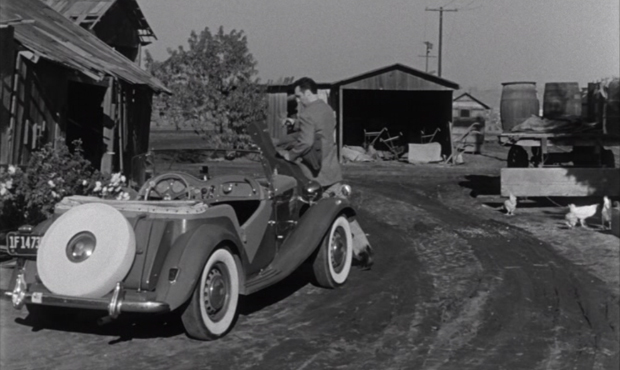
Nikki's car is a 1950 MG-TD that for some reason has a Jaguar hood ornament.
We all are aware of 114 and Dr. Strangelove and A Clockwork Orange. It's believed he began using 114 because of CRM-114 in Dr. Strangelove, but instead he may have found 114 in the book upon which Strangelove was partly based to be interesting because he was already using 114.
In shot 114, in Killer's Kiss, Davey receives what will become a "fatal" punch from Kid Rodriguez in an incredible shot that gives us Davey's POV. Though Davey manages to stay in the fight a little longer, that punch is the beginning of the end. When Davey later is trying to rescue the kidnaped Gloria, holding a gun on her boss and one of his thugs while another thug unties her, the camera a couple of times focuses on the playing cards the thug against the wall is holding, and then those cards are tossed at Davey's face and take him down, just as the end of the boxing match began with the near knock-out punch in shot 114. The cards are an ace of spades (11) and 4 of spades. 11-4. In the fight at the warehouse, however, Davey does eventually manage to get back up, catapult himself out the window, and later wins in his fight against Vincent.
When you think about it, you can compare that knock-out punch at 114 to the "busted position" in a chess game, as described in the second section on the chess and checkers club and how at the NY Chess and Checkers Academy kaddish was said when a busted position was recognized.
Finding seeming instances of 114 in Kubrick's films before Strangelove one is put in the position of, "Is intentional use really there pre-Strangelove? Or am I looking for use to be there because 114 is used later? Or will I discount the use of 114 before Strangelove because it was in the book upon which Strangelove was based and so Kubrick must have picked it up from that and couldn't have used it before." However, not only do we have 114 used perhaps in Killer's Kiss but also in Lolita, which I discuss toward the end of this post.
I have already written of how we see 504 and 405 at Nikki's farm, on the targets used for shooting practice, and how these may connect with the 504 street address of Marvin's apartment. 11:40 also connects Nikki's farm, where we had the target practice, with Marvin's place, which is 411 in the book though not in the film. In the film it is 504.
235 Niki drives up to the parking lot at the track. (57:17)
NARRATOR: He arrived at the track at 12:30.
236 Nikki and the parking lot attendant. (57:25)
NIKKI: Hi there.
PARKING LOT ATTENDANT: Use the other parking lot, mister. This one ain't open yet.
NIKKI: I don't like to trouble you.
PARKING LOT ATTENDANT: You're not troubling me. I said there's no parking here. There's no parking and that's that.
NIKKI: Look, mac. I'm a paraplegic. I want to get in this lot to watch the races from my car.
PARKING LOT ATTENDANT: That ain't my problem, mister. My leg's bum, too, but nobody's feeling sorry for me.
NIKKI: I know what you mean, buddy.
PARKING LOT ATTENDANT: Get that in the war?
NIKKI: Battle of the Bulge. Say, look, I know this is a lot of extra trouble for you. (Slips money in his pocket.) I want you to have this.
PARKING LOT ATTENDANT: No, no, no. Skip it. Skip it.
NIKKI: I want you to...
237 MS Nikki from beyond the attendant's right. (58:01)
NIKKI: ...take it. Now, go on. Keep it.
238 Nikki and the parking lot attendant. (58:04)
NIKKI: It's all right.
PARKING LOT ATTENDANT: Well, thanks a lot, mister. I'm sorry I...
NIKKI: That's okay. Forget it. Say, will you take down that fence? I'd like to get settled down before the first race starts. Okay?
PARKING LOT ATTENDANT: Sure, mister.
239 LS The car beyond the fence. (58:17)
The attendant moves it and Nikki drives through.
240 LS Nikki parking his car. (58:29)
241 MLS from behind Nikki before blue screen of track. (58:36)
Crossfade to shot 242.
Shot 235 | Shot 236 |
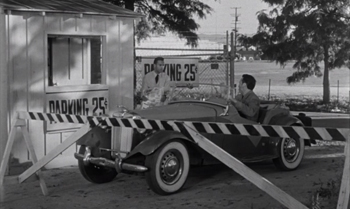 | 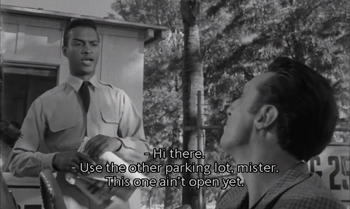 |
Shot 237 | Shot 238 |
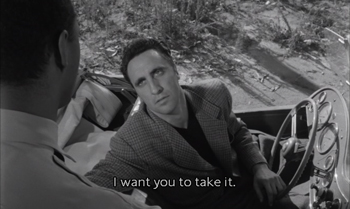 |  |
Shot 239 | Shot 240 |
 | 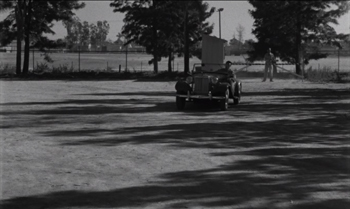 |
Shot 241 | |
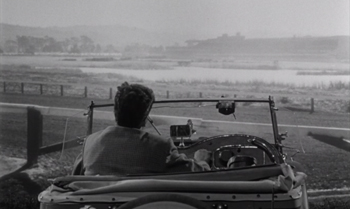 | |
242 Loudspeakers. (58:42)
243 Horses parade down track. (58:45)
ANNOUNCER: Your attention, please. The horses are now on the track for the second race at six furlongs.
Crossfade to shot 244.
244 MLS The parking lot attendant approaches Nikki's car, the lot filled up. (58:53)
PARKING LOT ATTENDANT: I had this lying around, mister. I thought you might like to have it.
NIKKI: Oh, thanks, that's very kind of you. (Taking the schedule.)
PARKING LOT ATTENDANT: No trouble at all. If you need anything else, just honk.
NIKKI: I doubt if I'll need anything. I'm getting along just fine. But thanks, anyway.
PARKING LOT ATTENDANT: Who you betting on, mister? Anything look good to you?
245 MCU Nikki. (59:10)
NIKKI: Red Lightning.
PARKING LOT ATTENDANT: Huh?
NIKKI: Red Lightning in the seventh.
PARKING LOT ATTENDANT: So you're betting on him, huh?
NIKKI: Yeah, I got a little bet down on him.
He holds up the binoculars to look through them.
246 MLS from behind Nikki before blue screen of track. (59:18)
PARKING LOT ATTENDANT: Well, I guess I better be getting back to work.
NIKKI: Well, thanks for bringing me the program.
247 MCU Parking Lot Attendant. (59:23)
PARKING LOT ATTENDANT: No trouble at all. You sure there's...
248 MCU Nikki looking through binoculars. (59:24)
PARKING LOT ATTENDANT: ...nothing else I can do for you.
NIKKI: No. Nothing at all. If I think of anything, I'll give you a yell.
Crossfade to shot 249.
Shot 242 | Shot 243 |
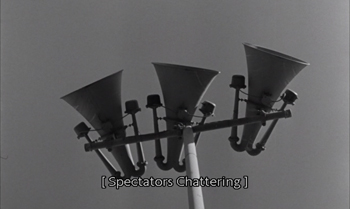 | 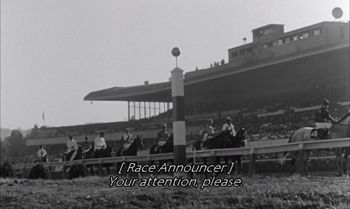 |
Shot 244 | Shot 245 |
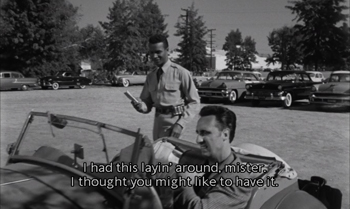 | 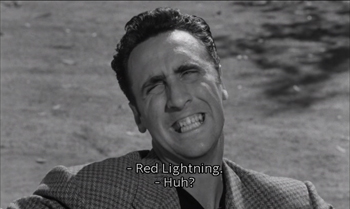 |
Shot 246 | Shot 247 |
 | 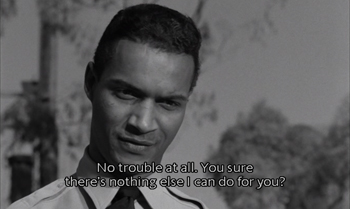 |
Shot 248 | |
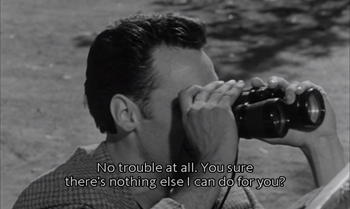 | |
249 Horses racing. (59:32)
250 Crowd. (59:39)
Very long crossfade superimposition moving from shot 249 to shot 250.
251 Horses racing. (59:42)
Long crossfade superimposition from shot 250 to 251.
252 The crowd and aerial of horses racing. (59:46)
Long crossfade from shot 251 to 252.
253 Loudspeakers. (59:51)
Crossfade from shot 252 to 253.
ANNOUNCER: Your attention...
254 Horse being led out to the track. (59:54)
ANNOUNCER: ...ladies and gentlemen. The horses are now on the track...
Shot 2 in the opening is the same as shot 201 and 254 and 283.
255 U-turn of horses on the track. (59:57)
ANNOUNCER: ...for the seventh race, the $100,000...
256 The horses parading down the track. (1:00:00)
ANNOUNCER: ...added Lansdowne Stakes at one mile...
Shot 4 in the opening is from the same footage as shot 203 and 256.
257 Loudspeakers. (1:00:05)
Crossfade from shot 256 to 257.
258 The draft horses pull the gate into place. (1:00:07)
ANNOUNCER: The horses are approaching the starting gate...
Shot 5 in the opening is the same as shot 206 and 258 and 286.
Crossfade to shot 259.
259 The horses taking their place in the gate. (1:00:07)
ANNOUNCER: ...for the seventh race.
Shot 7 in the opening is the same as shot 207 and 259
Shot 249 | Shot 250 |
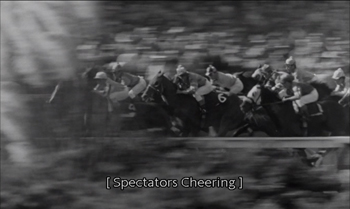 |  |
Shot 251 | Shot 252 |
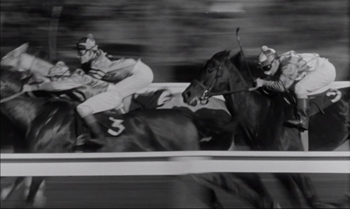 | 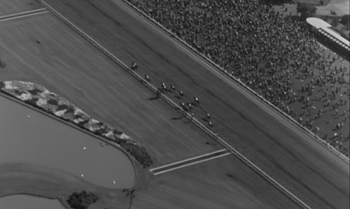 |
Shot 253 | Shot 254 |
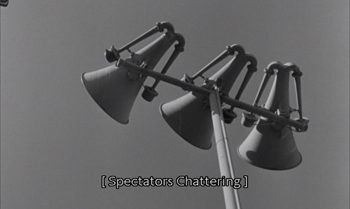 | 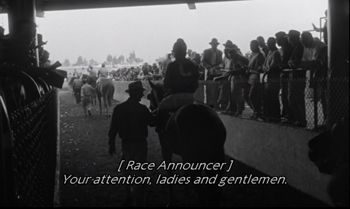 |
Shot 255 | Shot 256 |
 | 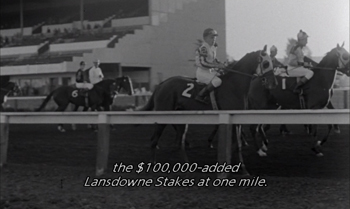 |
Shot 256a | Shot 257 |
 |  |
Shot 258 | Shot 259 |
 | 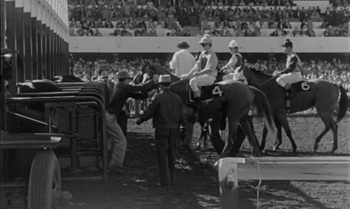 |
260 MS Nikki looking through binoculars. (1:00:16)
261 MLS from behind of Nikki against the blue screen. (1:00:20)
262 MS of Nikki from the front with the parking lot attendant approaching from behind. (1:00:24)
PARKING LOT ATTENDANT: Sure is a nice day, ain't it?
NIKKI: Yeah.
PARKING LOT ATTENDANT: Yes, sir. I didn't figure it would be when I first got up this morning, but it turned out real fine. Kinda funny when you stop to look at it. Weather's almost the same as it always is this time of year, but...I sure appreciate the way you treated me, mister.
263 MLS from behind of Nikki against the blue screen. (1:00:44)
PARKING LOT ATTENDANT: It's not so much the money. Of course, I appreciate that, too, but it's more the way...
NIKKI: Forget it.
PARKING LOT ATTENDANT: No, sir, I don't reckon I'll ever forget it. (Holds out an oversize horse shoe.) I brought you some luck, mister. You betting this race, I figure you might need it.
NIKKI: Oh, now, look. Keep your junk and leave me alone, will you?
264 MS of Nikki from the front with the parking lot attendant. (1:00:59)
PARKING LOT ATTENDANT: Some, something wrong?
NIKKI: You're wrong, nigger.
265 MCU Parking lot attendant. (1:01:02)
NIKKI: Now, be a nice guy and go on about your business.
266 MS of Nikki from the front with the parking lot attendant. (1:01:05)
PARKING LOT ATTENDANT: Sure, boss. Sorry to have bothered you. My mistake.
He throws the horseshoe down as he leaves.
267 MLS from behind of Nikki against the blue screen. (1:01:17)
He returns to looking through the binoculars.
268 Rear view of the horses in the gate. (1:01:21)
The bell rings and the horses are released.
ANNOUNCER: They're off and running! At the start it is Red Lightning breaking on top, Early Streak is second, I'm hoping...
269 MS of Nikki from the front. (1:01:32)
He puts down the windshield and takes out his gun.
ANNOUNCER: ...is third, White Fire is fourth, Little Arnie is next, Seymour's Darling and Best Seller. Moving down the back stretch it's Red Lightning by a length and a quarter.
270 The track. (1:01:43)
ANNOUNCER: I'm Hoping is second by three quarters of a length, Little Arnie is third by a length and a quater, and Seymour's Darling. (The horses come into view.) Passing the half-mile post, it is Red...
271 MS of Nikki readying the rifle. (1:01:51)
He puts down the windshield and takes out his gun.
ANNOUNCER: ...Lightning by a length and a quarter. I'm hoping is...
272 The track. (1:01:54)
ANNOUNCER: ...second by half a length, Seymour's Darling is third and...
273 MS of Nikki readying the rifle. (1:01:59)
ANNOUNCER: ...Little Arnie moving fast on the outside.
274 The track beyond Nikki's left shoulder. (1:02:01)
ANNOUNCER: Into the far turn, it is Red Lightning in front by a length and a quarter. Little Arnie is...
275 Horses on the track. (1:02:07)
ANNOUNCER: ... second by half a length.
276 MS of Nikki aiming the rifle. (1:02:09)
277 Horses on track from front and low. (1:02:09)
ANNOUNCER: I'm Hoping is third...
Gunshot. The horse goes down.
278 MS of Nikki. (1:02:10)
Nikki puts up his gun.
ANNOUNCER: And a horse is down! It is Red Lightning! At the head of the stretch, it is I'm Hoping taking the lead...
279 MLS Nikki starting his car. (1:02:17)
ANNOUNCER: ...by half a length, Little Arnie driving on the outside.
The tire blows out as he backs up and runs over the horse shoe. Air hisses. A polcieman appears in the background.
POLICEMAN: Hey, stop! Stop or I'll shoot!!
He fires once. Nikki starts to climb out of the car and is hit by the second gunshot.
ANNOUNCER: ...It's Little Arnie. Down to the wire it is Little Arnie going steadily...
Shot 260 | Shot 261 |
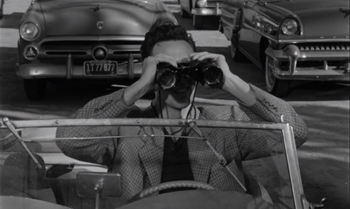 | 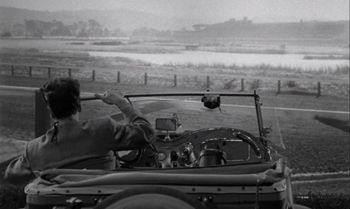 |
Shot 262 | Shot 263 |
 | 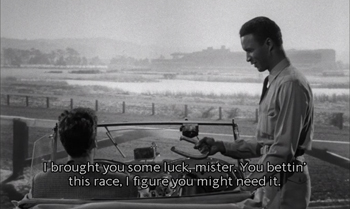 |
Shot 264 | Shot 265 |
 |  |
Shot 266 | Shot 267 |
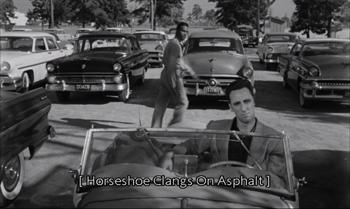 |  |
Shot 268 | Shot 259 |
 | 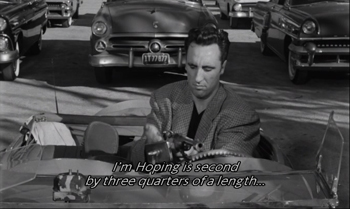 |
Shot 270 | Shot 271 |
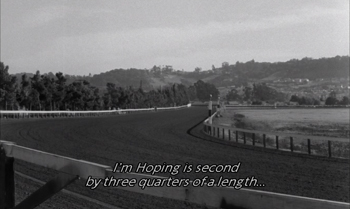 | 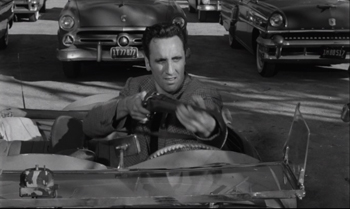 |
Shot 272 | Shot 273 |
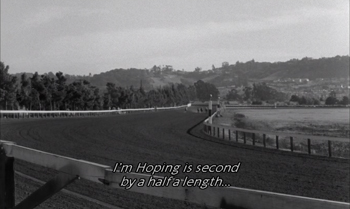 | 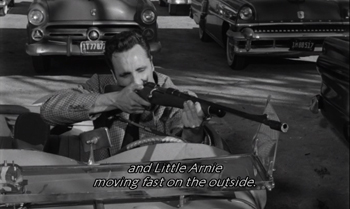 |
Shot 274 | Shot 275 |
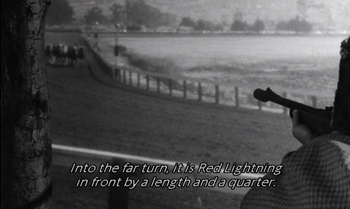 |  |
Shot 276 | Shot 277 |
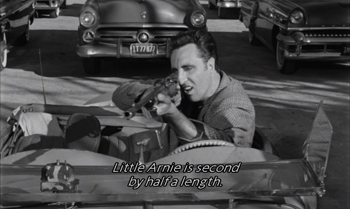 |  |
Shot 278 | Shot 279 |
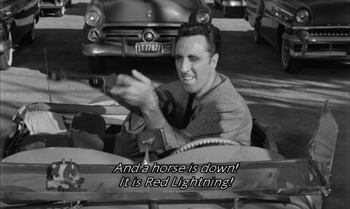 | 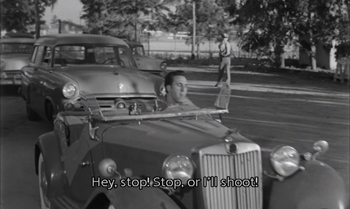 |
280 CU of the horse shoe embedded in the tire by Nikki's hand. (1:02:32)
ANNOUNCER: ...holding it and winning it!
NARRATOR: Nikki was dead at 4:24.
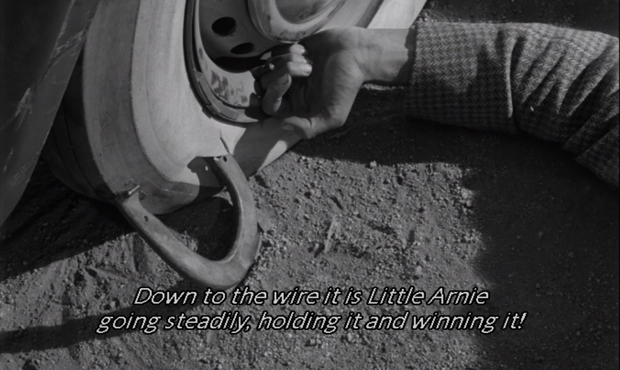
The big difference is Nikki doesn't die in the book.
The parking attendant in the book is not black. We have much the same conversation concerning Nikki saying he's paraplegic and the parking attendant finally allowing him in. The parking attendant later brings him a program but does not return with the horse shoe for luck. He doesn't throw the horseshoe down. The MG's tire is not pierced. There is no one on duty when Nikki drives off. He gets away clean, no problems.
So, Kubrick has inserted into the plot a racist incident that brings Nikki down. Nikki is acting a role so it's impossible to tell what his real feelings are toward the African-American attendant. He's nice, but he's thinking this will aid him in his endeavor. Then he acts the opposite of how he initially presented himself, but again he's doing this to get rid of the attendant who has become problematic with his friendliness. It's interesting that Kubrick takes this opportunity to comment on racism here, back in 1956, Rosa Parks having refused to move to the back of the bus in 1955. The lunch counter sit-ins, and the freedom riders had yet to happen, and the Civil Rights Act of 1964 was nearly a decade away. James Edwards, who plays the attendant, was in Manhandled, a 1949 film noir that featured Sterling Hayden, and in 1949 was also in The Set-Up, a boxing film that was advertised on the Criterion marquee in one of the Rosemary Williams photos Kubrick took for a LOOK feature that never ran. The Set-Up was based on a Joseph Moncure March poem about racial prejudice, with an African American in the lead role, but this ended up not happening when it was translated into film. The lead character was changed from African-American to white and the racial prejudice plot deleted.
Nikki uses an MG in the book. One reason he would be using an MG is because he can put the windshield down and shoot straight from his seat. But in the book, Nikki raises the canvas sides in order to help cloak him while he is shooting. This doesn't happen in the film.
In the novel it's not the bullet that initially kills the horse, though the horse would have died anyway. It's another horse's hoof going through the horse's skull where the bullet exited that kills the horse.
Of course, yes, it's ironic that what is supposed to bring Nikki luck instead helps lead to his downfall. The horseshoe, not in the book, seems almost used in the film as an entirely symbolic gesture, not realistically. We see, as Nikki begins to back up to drive away, that his tire is already flat, that the horseshoe isn't piercing it. Actually, first we hear the tire blow out, so it sounds like a gun shot, then we hear the hiss of air escaping. As this happens the officer comes running around the right and yells for Nikki to stop. Nikki drives forward. The officer shoots, misses, then shoots again. Again, as Nikki falls out of the car we see the flat tire, no horseshoe. Then we see the CU of the tire and the horseshoe is stuck through it. And how did it pierce so high up on that white wall anyway? Never mind. Never mind. It's symbolic. It's ironic. In the book, it's another horse's hoof going through the bullet's exit wound in the horse's skull that is the actual reason for its death. Here, a phantom horse's hoof gets Nikki.
Just noting that we have more sevens here, the car behind Nikki having the numbers 77877 in the license tag. We see that car behind Nikki several times, including shot 278 in which cars are parked to the left and right of that car, however in shot 279 there is no car parked to screen right of it. Instead, the police officer comes running up to screen right and shoots Nikki.
I've wondered if Kubrick referenced the film The Man Between in The Killing. We saw a marquee for the film in Killer's Kiss and I've considered that in Killer's Kiss he purposefully showed that marquee, as with Himberama, from which he takes an idea on audience intersection with the sage and rephrases it in the film.
The Man Between concerns a woman, Susanne, who is kidnapped to East Germany. Ivo, played by James Mason, is a man with whom she has become involved. The first husband of Susanne's sister-in-law, Ivo had been thought to be dead but was recently resurrected, which made his former wife a bigamist. He uncomfortably straddles the worlds of both East and West Germany, and hopes to be accepted as a refugee into West Germany, but he's had shady dealings in the past. When Susanne is mistaken for her sister-in-law and kidnapped into East Germany, he commits himself to helping her. An attempt to escape back to West Germany begins with a night at the opera. From the getaway car, Ivo throws out spikes that are shaped like U's (in other words, horse shoes), which puncture the tires of the car pursuing them.
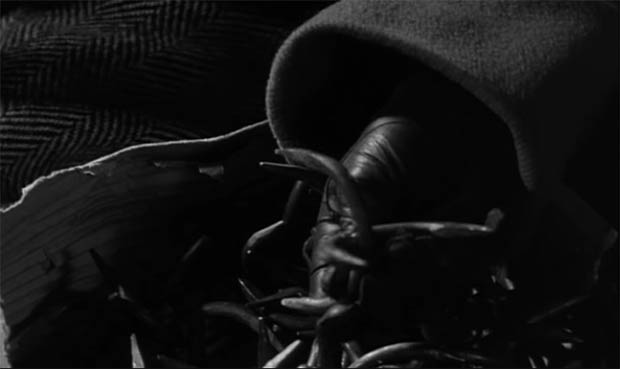
Wikipedia states that the sideways 8 infinity symbol may have been derived from the Roman numeral for 1000 (originally ⅭⅠↃ, also ⅭↃ), or omega, Ω, the 24th and final letter of the Greek alphabet.
Earlier in The Man Between, the way that Ivo sends a message to Susanne that he is not going to be able to make it to a meeting with her is by way of an infinity symbol made in the snow by a child on a bike.
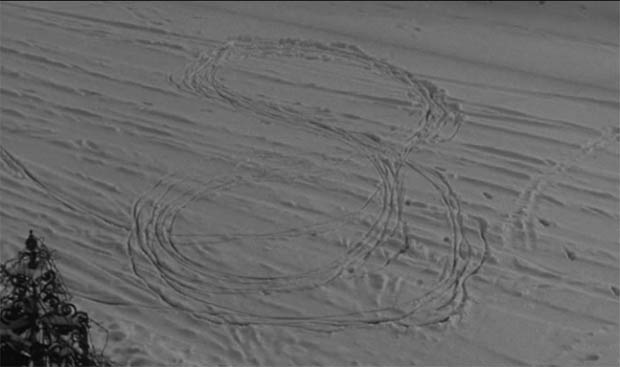
Whatever these things meant to Carol Reed, the director of The Man Between, in Section Four of this analysis I will be showing how he used s mirror motif to represent a somewhat irregular doubling, in which East and West don't quite match.
That infinity symbol is, in some respects, Ivo's downfall. The boy on the bike always follows Ivo because of an affectionate father-son bond between him. When Ivo (who lives in the East) is trying to make a permanent escape to the West with Susanne (who lives in the West but was kidnapped into the East), they are eventually hidden in the back of a truck being driven by an agent who has many times before made forays into East Germany and been successful in bringing back information, though on his last trip he barely escaped, having been bitten by a dog. The truck is stopped at the border and they aren't discovered until suspicion is raised by the boy who followed them on the bike, again making over and over the infinity symbol as he circles. Ivo had told the boy to go to school, not to follow them, but the boy is too attached and doesn't listen. The boy having attracted attention to the truck, the guards proceed to search it. Ivo slips out and runs, hoping the guards will follow him and the truck will be able to make its escape with Susanne. The truck does escape. Once the truck is over the border, Ivo attempts to run after it and is shot.
All of this is interesting to me in respect of Killer's Kiss, for in Killer's Kiss we have essentially an Orpheus story, Davey going into the underworld to rescue Eurydice. In that case it ends happily. And I think Kubrick in that film has a few visual references to Cocteau's Orphee in which Orpheus' infiltration also ended happily, but only because Death intentionally sent Orpheus and Eurydice back and erased their memories. Death can cross over to the world of the living, and the living can enter the world of the dead (via mirrors, with Cocteau) but in the end these worlds are divided from one another. One senses some of this land of the dead in Carol Reed's depiction of East Germany, bombed out, desolate (though Pluto is a god of wealth), Susanne as Persephone kidnapped and returned. She falls in love with Ivo, but Ivo is unable to cross back over from the east with her permanently.
One wonders if the dog bite is representative of Cerbeus.
But I'm not concerned here with what Carol Reed meant or didn't mean, instead I'm interested in what Kubrick might have possibly seen in these things in Reed's film and made of them.
Kubrick here employees the Omega symbol in the horse shoe while in the background we see the infinity symbol represented in the license plate number which has mirroring numbers to either side of the 8. 77877.
How can we guess that Kubrick is dealing with such symbols here as the infinity symbol and Omega? I think the fact that Nikki is dead precisely at 4:24 is a decided clue, Ω being the 24th letter of the Greek alphabet. We have an infinity loop.
Kubrick also used the horseshoe in The Shining and also in proximity of a boy on a bike--Danny on his tricycle. We first see a good luck horseshoe hanging in the switchboard room when Wendy discovers the phone lines are down. They are thus out of communication. Earlier in the film we had seen Danny making circles around the Colorado Room and then outside room 237. Following the switchboard and radio scene with Wendy, we see Danny cycling again through the hotel but this time he runs into the twin girls. Beside the murder scene of them is the heel of a shoe that reminds of the horseshoe. Does Kubrick bring in the horseshoe to explicitly refer back to the boy on the bike in The Man Between, referring as well to the horseshoe in The Killing?
In both The Killing and The Man Between the horseshoe shape is connected with a blown tire. In Lolita, a decisive moment is had when a car is following Humbert and Lolita in a desolate area of the Badlands and their tire blows out. It sounds like a gun shot. The man (Quilty) who was following them turns around. It is for all intents and purposes the end of Humbert and Lolita's journey as well. Coincident with this, the 9s on the odometer roll over. Not long before that scene, Humbert already suspecting that a car might be following them, Kubrick has them stop at a Mobil gas station decorated with its Pegasus trademark. A flying horse. A version of the Buraq. The film is black-and-white so one can't tell Pegasus is bright red in the trademark, which may remind of Red Lightning.
The figure 8, as I noted, is derived from mirroring omegas on either side of a line--also, simply, omega, the 24th and last letter of the alphabet. It also represented 1000.
After Danny sees the girls, he no longer will be observed to be riding his bike. It's as if its tire blows out as well.
I don't know the source but I've read that the studio, in order to make the timeline clear for the audience, insisted that the narrative be added. True? Not true? I don't know. What happens if we remove it for this day? What if we remove the narration? Combining sections 3 and 4 in this analysis, things go fine up to the point when Randy parks under the window at the racetrack at the beginning of the seventh race. People could assume these events were sequential and there would be no confusion, the narrative wouldn't suffer at all. It's after Randy parks under the window that we have the first episode in the film where we have an obvious flashback with Maurice still being at the chess club (2:30), then the plot moves forward and takes us into the action in the 7th race and Maurice's fight. Then the same with Nikki leaving his farm (11:40); again, this is another flashback that ends up taking us right into the seventh race. One can look at it this way, it's with the beginning of the 7th race at 4:20 that we start having obvious flashbacks in time. Both of these flashbacks concern a doubled character, for Maurice is played by Nicholas, Nikki, Kwarini. After Nikki's death at 4:24, we have another obvious flashback with Johnny to his buying the briefcase (2:15), then we move forward and continue through the entire heist scene to its conclusion.
Next we go to Marvin's at 7:15. The flashback to Johnny at the motel is not an obvious flashback. We know that Johnny is late, not why, and without the narrative we might assume the scene at the motel naturally follows. We might then realize it was instead a flashback when Johnny arrives at Marvin's and George stumbles out and falls onto the hood of the car. After that the action is straightforward to the end.
Thus, the only parts of the movie in which we have obvious flashbacks (exempting possibly Johnny's last visit to the cabin motel) are when we move back to Maurice at the chess club, Nikki leaving the farm, and Johnny leaving Jeffrey's luggage. The race is repeated 4 times, once with Randy, once with Maurice, once with Nikki and once with Johnny. If we include shots from the race used under the credits, the race is repeated 5 times.
August 2014 transferred to html. Approx words or 26 single-spaced pages. A 98 minute read at 130 wpm.
Go to Part 4
Go to Table of Contents of the analysis
Link to the main TOC page for all the analyses